Interesting, but not my style.
You are using an out of date browser. It may not display this or other websites correctly.
You should upgrade or use an alternative browser.
You should upgrade or use an alternative browser.
Custom Builds From Bikebrewers
- Thread starter DaveM
- Start date

Help Support Triumph Motorcycle Forum:
This site may earn a commission from merchant affiliate
links, including eBay, Amazon, and others.
BRAAP on the BMW R100 Bobber
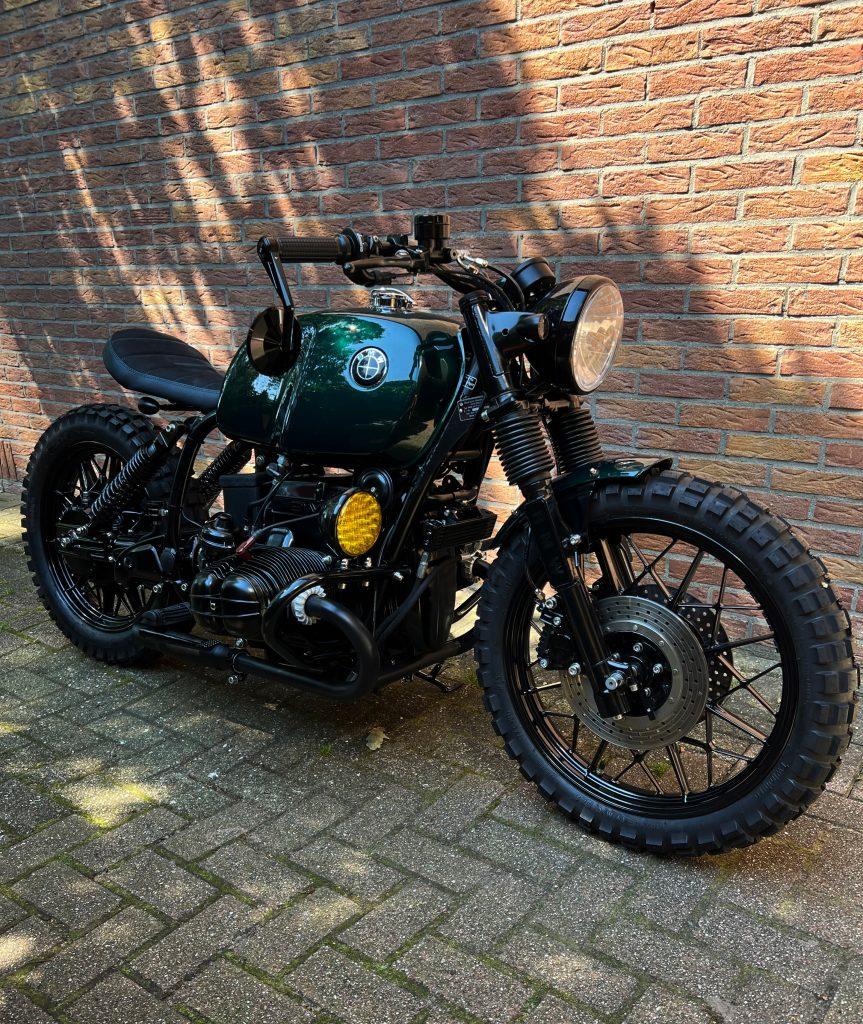
When another BMW Bobber rolls out of the Walzwerk or Ironwood garage we know what to expect. It is all the more surprising when a BMW Bobber of the same build quality rolls out of a garage that is not that well known (yet!). Erwin Dijkstra at Moto Braap did just that! He surprised us with a build that is up to par with the names we all know.
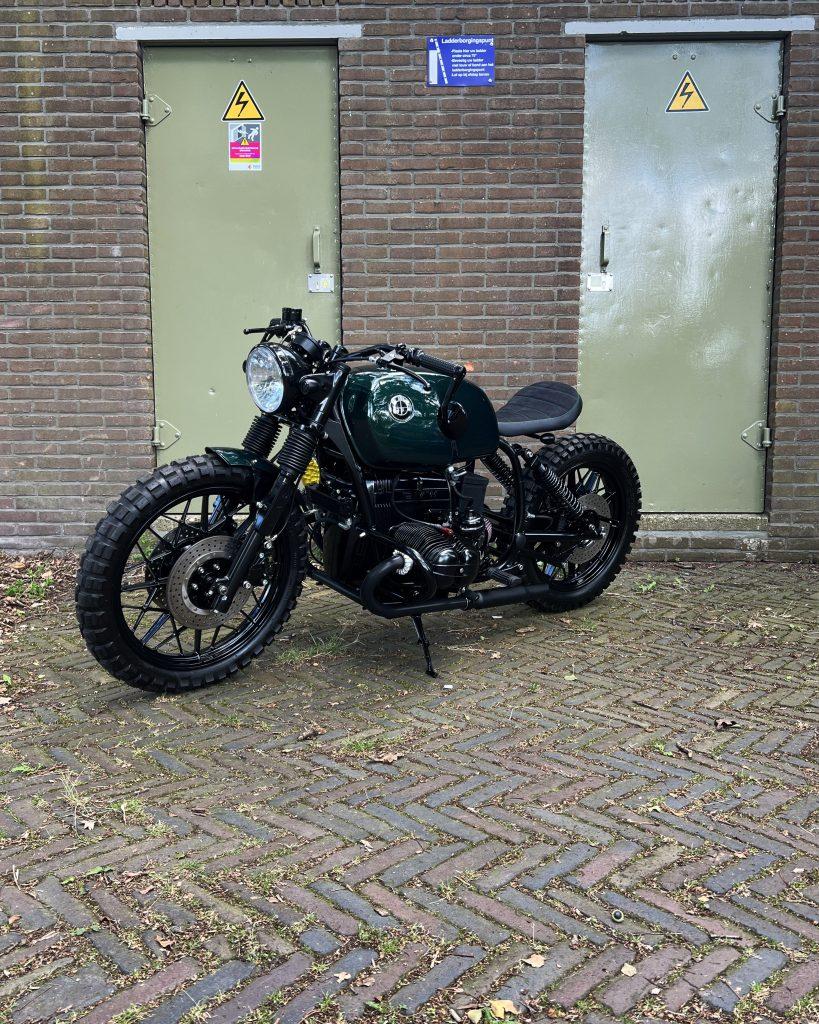
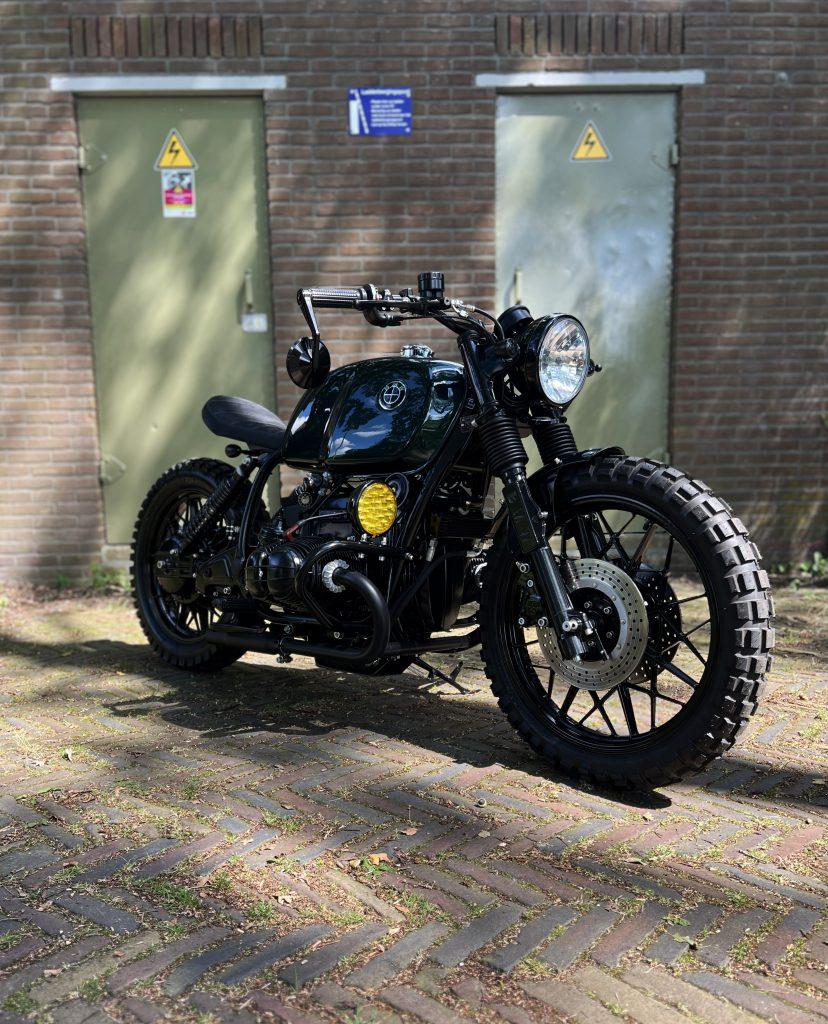
This bobber started its life in Germany in 1984 as a full fairing BMW R100RT, and got a facelift in the Netherlands about 40 years later. It’s been on a bit of diet in both the front and rear, losing its fairing and its rear subframe. The YSS rear shocks mount directly to the frame underneath the custom solo seat from Silvermachine. This subframe also houses the Kellerman 3-in-1 taillight, brake light, and indicators. In the front the forks were shortened to ensure a straight line front to back and adorned with CNC milled BMW emblems.
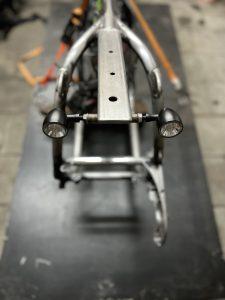
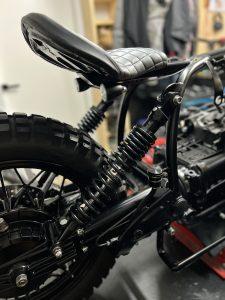
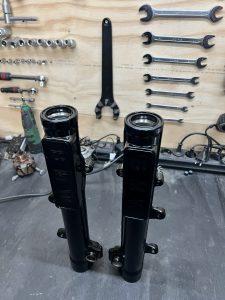
The tank and front fender pop with Porsche Jet Green, because the rest of the bike is blacked out. The frame, swingarm, final drive, fork sliders, wheels, and engine guards were powder coated, whereas the engine, gearbox, and callipers were painted black. To top it off, the exhaust system has a black ceramic coating.
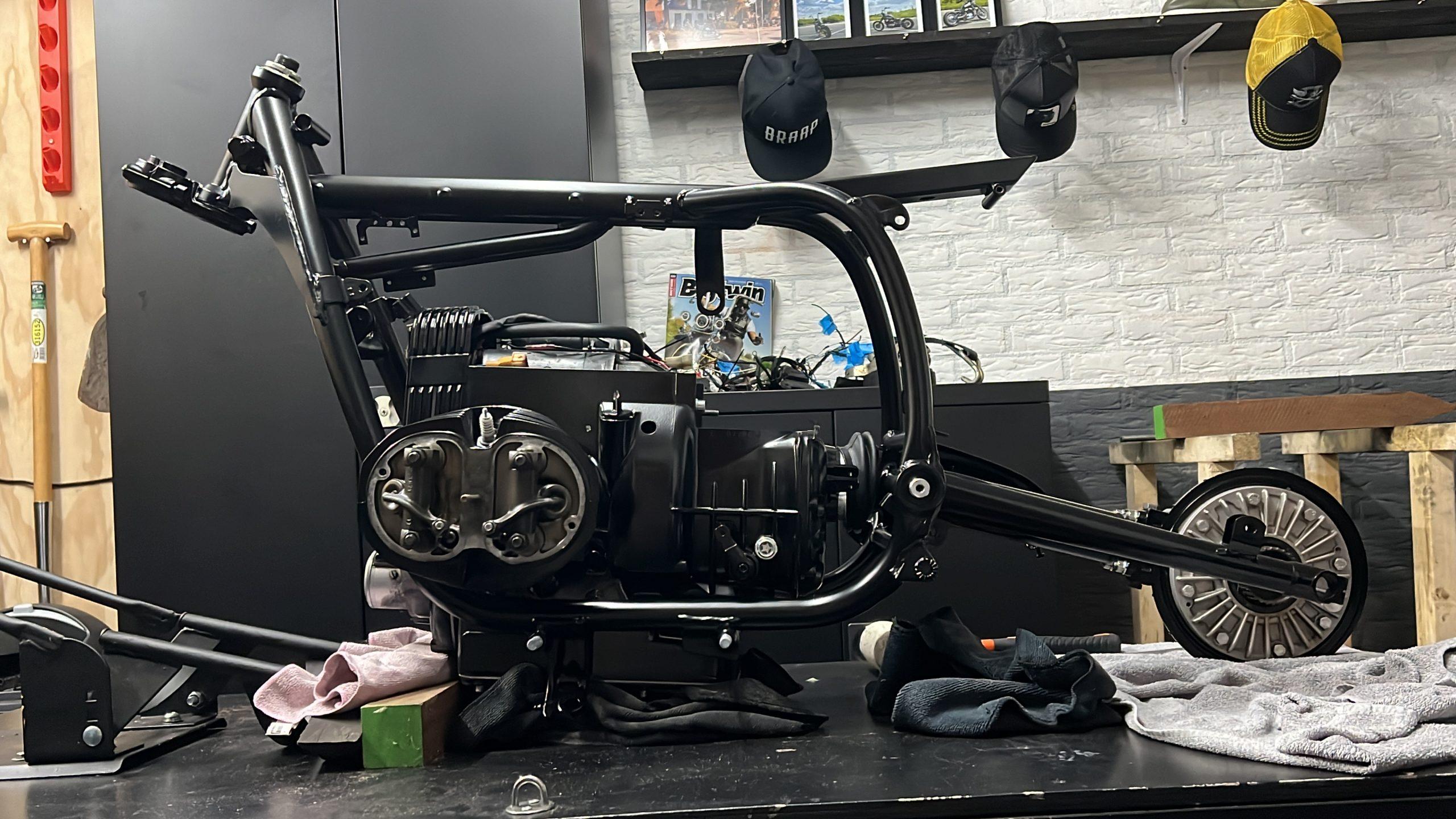
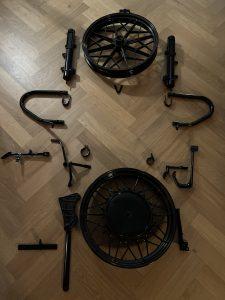
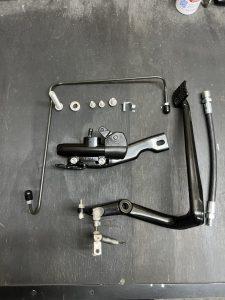
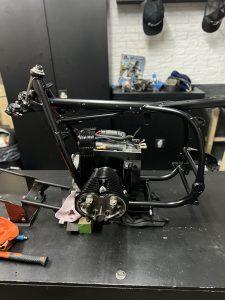
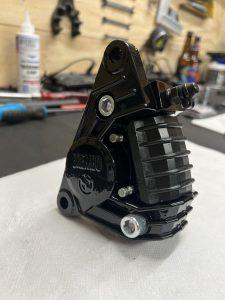
Electrically a Daytone clock keeps track of the different sensors, speed, and revs, while cleaning up the normally bulky cockpit. The blacked out original headlightmaintains a classic look to the bike. The battery now sits atop the gearbox, as the airbox gave way to two pod filters. Combined with the black ceramic exhaust this really opens up the bike. We are therefore convinced that this bobber is not just nice to look at, but also a hoot to ride!
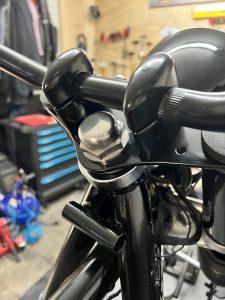
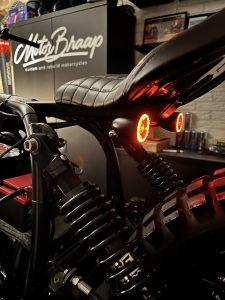
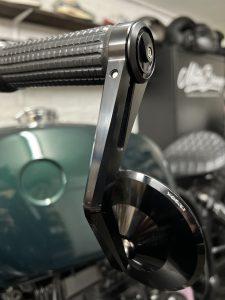
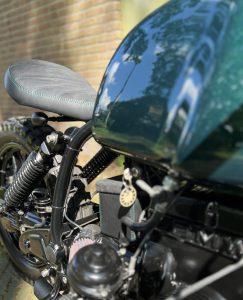
The post BRAAP on the BMW R100 Bobber appeared first on BikeBrewers.com.
Continue reading...

When another BMW Bobber rolls out of the Walzwerk or Ironwood garage we know what to expect. It is all the more surprising when a BMW Bobber of the same build quality rolls out of a garage that is not that well known (yet!). Erwin Dijkstra at Moto Braap did just that! He surprised us with a build that is up to par with the names we all know.


This bobber started its life in Germany in 1984 as a full fairing BMW R100RT, and got a facelift in the Netherlands about 40 years later. It’s been on a bit of diet in both the front and rear, losing its fairing and its rear subframe. The YSS rear shocks mount directly to the frame underneath the custom solo seat from Silvermachine. This subframe also houses the Kellerman 3-in-1 taillight, brake light, and indicators. In the front the forks were shortened to ensure a straight line front to back and adorned with CNC milled BMW emblems.



The tank and front fender pop with Porsche Jet Green, because the rest of the bike is blacked out. The frame, swingarm, final drive, fork sliders, wheels, and engine guards were powder coated, whereas the engine, gearbox, and callipers were painted black. To top it off, the exhaust system has a black ceramic coating.





Electrically a Daytone clock keeps track of the different sensors, speed, and revs, while cleaning up the normally bulky cockpit. The blacked out original headlightmaintains a classic look to the bike. The battery now sits atop the gearbox, as the airbox gave way to two pod filters. Combined with the black ceramic exhaust this really opens up the bike. We are therefore convinced that this bobber is not just nice to look at, but also a hoot to ride!




The post BRAAP on the BMW R100 Bobber appeared first on BikeBrewers.com.
Continue reading...
Wheels & Wake – sand beach racing and more in the North of Germany
WHEELS
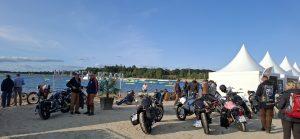
You may have heard of the late-spring event in Biarritz in the south of France, called Wheels and Waves, but we chose to visit the Northern version – in the upper part of Germany, Nethen Beach to be exact, called Wheels & Wake!
Now this place is actually only a 3,5 hours drive from Amsterdam, or 2 hours from Hamburg, just 60 kilometers from Bremen, but you’ll definitely need the route-planner on your phone to get you there. It is kind of in the middle of nowhere, but when you arrive – be prepared for a great party!
It’s an all-weekend event, second weekend of September, with flat-track racing at nearby Moorwinkelsdamm on Friday night and then drag-racing on the beach on Saturday and Sunday. Quite a few cool custom bikes from renowned builders as well as from visitors on display, among which this year the spectacular ZWEI lightweight bike by Wannabe Choppers.
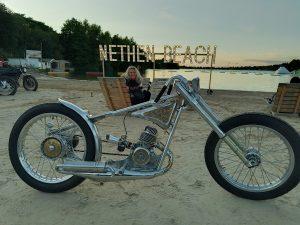
Plus a really relaxed atmosphere, some cool stands with custom builders, parts and clothing, and plenty of food to be had as well. And lots of beer of course – we are in Germany after all! Camping grounds are available right outside the event grounds, so you don’t have to worry about having a couple…
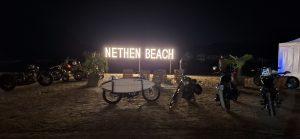
I only came on Saturday so missed the “Friday Night Flattrack”, but was all fired up to participate in the “1/32 Mile Worldchampionship of Sandy Beach Motorcycle Racing” on Saturday!
Unfortunately I could not bring my 1971 Montesa Cota to life, so couldn’t compete…
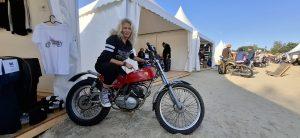
But the racing was great fun, with a great variety of bikes ranging from stock road bikes to completely customized sand-racers…
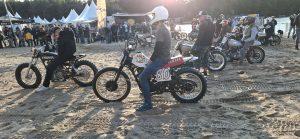
You have all of 1/32th of a mile in the sand to outrun your opponent, which is just over 50 meters for us metric folks, but that’s enough for some daredevils to get to impressive speeds!
The pre-inscribed and vetted racers get to battle it out during the day on Saturday. But after the new “World Champion of Sandy Beach Racing” has been crowned in the early evening, everyone can have a run on the track! With the fastest competitors then going one-on-one again on Sunday.
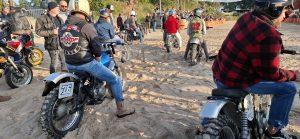
Saturday night after the racing the party starts, with live bands outside, disco in the big tent, and more beer of course! Watching some of these guys in full black leather swinging their couple-hundred-pound bodies to the disco beat was quite impressive as well, I must say.
All in all, a great way to spend a weekend in September, whether you go out to compete or just watch.
So if you weren’t there this year, be sure to come out to the sandy beach 11-14 September 2025 to enjoy “LOVE, PEACE, MOTORCYCLES”, Wheels and Wake’s motto!

The post Wheels & Wake – sand beach racing and more in the North of Germany appeared first on BikeBrewers.com.
Continue reading...
WHEELS  ️ WAKE
️ WAKE

You may have heard of the late-spring event in Biarritz in the south of France, called Wheels and Waves, but we chose to visit the Northern version – in the upper part of Germany, Nethen Beach to be exact, called Wheels & Wake!
Now this place is actually only a 3,5 hours drive from Amsterdam, or 2 hours from Hamburg, just 60 kilometers from Bremen, but you’ll definitely need the route-planner on your phone to get you there. It is kind of in the middle of nowhere, but when you arrive – be prepared for a great party!
It’s an all-weekend event, second weekend of September, with flat-track racing at nearby Moorwinkelsdamm on Friday night and then drag-racing on the beach on Saturday and Sunday. Quite a few cool custom bikes from renowned builders as well as from visitors on display, among which this year the spectacular ZWEI lightweight bike by Wannabe Choppers.

Plus a really relaxed atmosphere, some cool stands with custom builders, parts and clothing, and plenty of food to be had as well. And lots of beer of course – we are in Germany after all! Camping grounds are available right outside the event grounds, so you don’t have to worry about having a couple…

I only came on Saturday so missed the “Friday Night Flattrack”, but was all fired up to participate in the “1/32 Mile Worldchampionship of Sandy Beach Motorcycle Racing” on Saturday!
Unfortunately I could not bring my 1971 Montesa Cota to life, so couldn’t compete…

But the racing was great fun, with a great variety of bikes ranging from stock road bikes to completely customized sand-racers…

You have all of 1/32th of a mile in the sand to outrun your opponent, which is just over 50 meters for us metric folks, but that’s enough for some daredevils to get to impressive speeds!
The pre-inscribed and vetted racers get to battle it out during the day on Saturday. But after the new “World Champion of Sandy Beach Racing” has been crowned in the early evening, everyone can have a run on the track! With the fastest competitors then going one-on-one again on Sunday.

Saturday night after the racing the party starts, with live bands outside, disco in the big tent, and more beer of course! Watching some of these guys in full black leather swinging their couple-hundred-pound bodies to the disco beat was quite impressive as well, I must say.
All in all, a great way to spend a weekend in September, whether you go out to compete or just watch.
So if you weren’t there this year, be sure to come out to the sandy beach 11-14 September 2025 to enjoy “LOVE, PEACE, MOTORCYCLES”, Wheels and Wake’s motto!

The post Wheels & Wake – sand beach racing and more in the North of Germany appeared first on BikeBrewers.com.
Continue reading...
Silver Machine – crafting custom saddles made to last
Jeroen’s journey as a motorcycle saddle-maker started some 8 years ago when he, working at a motorcycle dealer but trained as a tailor, crafted a seat for a colleague. This guy was happy with the result, showing it to his friends, which led to more requests, which led to even more demand, and what began as a hobby has since evolved into a full-fledged business. Three years ago Jeroen moved from cramped quarters in Amsterdam to the quieter Veluwe in the east of the Netherlands, where he found a much bigger workshop in Ermelo.
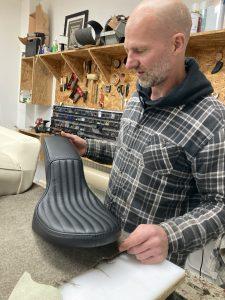
Jeroen’s clientele today consists of a mix of local and international motorcycle enthusiasts, custom builders, as well as collectors.
While he started building his network in the riding community of Amsterdam, right from the start he posted photos of his creations on Facebook – and later Instagram – and soon orders started to come in online as well. Today, Jeroen’s custom saddles are finding homes not just in the Netherlands, but also in the US, as well as in far-flung places like Dubai, Japan, Singapore, or even Kenya…
Jeroen is the saddle-maker of choice for renowned builders like Arjen van der Boom, Timothy Somers of Powerbrick Performance and Ronna Noren of Unique Custom Cycles. He builds the custom seats to fit their custom projects, ranging from BMW K100 series, all types of Harley Davidsons to Indian prototypes and much much more. More recently, his work for collectors of antique motorcycles has even led to building complete interiors for cars like vintage Porsches.

But the bulk of Jeroen’s business remains to be custom motorcycle saddles. While this mostly concerned cafe racers when he started, today most of his projects are saddles for choppers and for more contemporary models of in particular Harley-Davidson, such as Road Kings or Pan Americas.
Silver Machine customers have been and still are very positive, with many sending photos of their completed rides with new saddles in place, proud and happy…

Jeroen produces several hundred saddles per year, each one a labor of love…. There is always a stack of seat bases, ready to be built up with foam and leather, waiting for Jeroen to get to, so turnaround time is typically around four weeks.
So what sets Jeroen apart? For one, it’s his dedication to quality. “I love working with real, full-grain leather,” he says. Using the best materials ensures that each saddle not only looks great but will age beautifully over time.

And, in his own words, “It’s all about simplicity and attention to detail.” His philosophy is to keep his work clean and simple, focusing on precision and excellent workmanship.
All in all, Silver Machine saddles are proof that true craftsmanship never goes out of style.

The post Silver Machine – crafting custom saddles made to last appeared first on BikeBrewers.com.
Continue reading...
Jeroen’s journey as a motorcycle saddle-maker started some 8 years ago when he, working at a motorcycle dealer but trained as a tailor, crafted a seat for a colleague. This guy was happy with the result, showing it to his friends, which led to more requests, which led to even more demand, and what began as a hobby has since evolved into a full-fledged business. Three years ago Jeroen moved from cramped quarters in Amsterdam to the quieter Veluwe in the east of the Netherlands, where he found a much bigger workshop in Ermelo.

Jeroen’s clientele today consists of a mix of local and international motorcycle enthusiasts, custom builders, as well as collectors.
While he started building his network in the riding community of Amsterdam, right from the start he posted photos of his creations on Facebook – and later Instagram – and soon orders started to come in online as well. Today, Jeroen’s custom saddles are finding homes not just in the Netherlands, but also in the US, as well as in far-flung places like Dubai, Japan, Singapore, or even Kenya…
Jeroen is the saddle-maker of choice for renowned builders like Arjen van der Boom, Timothy Somers of Powerbrick Performance and Ronna Noren of Unique Custom Cycles. He builds the custom seats to fit their custom projects, ranging from BMW K100 series, all types of Harley Davidsons to Indian prototypes and much much more. More recently, his work for collectors of antique motorcycles has even led to building complete interiors for cars like vintage Porsches.

But the bulk of Jeroen’s business remains to be custom motorcycle saddles. While this mostly concerned cafe racers when he started, today most of his projects are saddles for choppers and for more contemporary models of in particular Harley-Davidson, such as Road Kings or Pan Americas.
Silver Machine customers have been and still are very positive, with many sending photos of their completed rides with new saddles in place, proud and happy…

Jeroen produces several hundred saddles per year, each one a labor of love…. There is always a stack of seat bases, ready to be built up with foam and leather, waiting for Jeroen to get to, so turnaround time is typically around four weeks.
So what sets Jeroen apart? For one, it’s his dedication to quality. “I love working with real, full-grain leather,” he says. Using the best materials ensures that each saddle not only looks great but will age beautifully over time.

And, in his own words, “It’s all about simplicity and attention to detail.” His philosophy is to keep his work clean and simple, focusing on precision and excellent workmanship.
All in all, Silver Machine saddles are proof that true craftsmanship never goes out of style.

The post Silver Machine – crafting custom saddles made to last appeared first on BikeBrewers.com.
Continue reading...
1965 BSA Lightning ground-up restoration
When I lived in New York City (NYC) in the mid nineties, I found the high energy of the place really inspiring. So much music, so much art, and such a great custom motorcycles scene..
I seems that a couple decades later that energy is still very much there, certainly when we take a closer look at what Joshua Lutz is up to….
Besides playing dozens of musical instruments, running a production studio and a rental company, working on numerous albums and films, he also is rebuilding and customizing motorcycles under the Clubman Cycles name.
Joshua’s latest completed project is a 1965 BSA Lightning, which turned out not to be his typical build however…

This particular BSA Joshua uncovered by chance in the backyard of an apartment complex in Queens NYC back in 2016. After he convinced the hipster owner to sell it to him and brought it over to the Clubman headquarters, it turned out there was almost nothing on the bike that didn’t need a complete rebuild…
So it took 7 plus years and a mountain of work – not to mention determination – to get this 60-year old bike running again!

The tank was badly rusted and had to be acid etched plus needed some serious metal work before it was as-proof and in its original shape again. Next came a total rebuild of the engine. This was expertly handled by John’s Motorcycle Repair Shop out of Woodside, Queens, who specialized in old British bikes. John has since closed shop, but he really knew and loved BSA’s. Joshua recalls him saying “nothing looks sexier spitting oil all over the place than a BSA.”
Except for the frame and wheels, pretty much everything else needed to be rebuilt or replaced as well – brakes, forks, electrical, transmission, lights, paint…

Resulting in a 7-year journey and a serious chunk of cash to get it to the beautiful bike it is today, which really is a blast to ride.
As Joshua says: “yea, it weeps oil and spits gas like a baby with colic, but that’s the case with every vintage British bike….”
Besides the ground-up restoration, Joshua added some custom touches like the flat-tracker leather seat which rests on a hand-fabricated redesigned rear frame, new straight HD pipes mounted on handmade hardware – all in shining chrome, new Clubman bars, levers, and cables… Not to mention the vintage NOS red grips, matching the red gas lines. All in all, a really nice bike to look at and to ride – now looking for a new owner as we understand it…


The post 1965 BSA Lightning ground-up restoration appeared first on BikeBrewers.com.
Continue reading...
When I lived in New York City (NYC) in the mid nineties, I found the high energy of the place really inspiring. So much music, so much art, and such a great custom motorcycles scene..
I seems that a couple decades later that energy is still very much there, certainly when we take a closer look at what Joshua Lutz is up to….
Besides playing dozens of musical instruments, running a production studio and a rental company, working on numerous albums and films, he also is rebuilding and customizing motorcycles under the Clubman Cycles name.
Joshua’s latest completed project is a 1965 BSA Lightning, which turned out not to be his typical build however…

This particular BSA Joshua uncovered by chance in the backyard of an apartment complex in Queens NYC back in 2016. After he convinced the hipster owner to sell it to him and brought it over to the Clubman headquarters, it turned out there was almost nothing on the bike that didn’t need a complete rebuild…
So it took 7 plus years and a mountain of work – not to mention determination – to get this 60-year old bike running again!

The tank was badly rusted and had to be acid etched plus needed some serious metal work before it was as-proof and in its original shape again. Next came a total rebuild of the engine. This was expertly handled by John’s Motorcycle Repair Shop out of Woodside, Queens, who specialized in old British bikes. John has since closed shop, but he really knew and loved BSA’s. Joshua recalls him saying “nothing looks sexier spitting oil all over the place than a BSA.”
Except for the frame and wheels, pretty much everything else needed to be rebuilt or replaced as well – brakes, forks, electrical, transmission, lights, paint…

Resulting in a 7-year journey and a serious chunk of cash to get it to the beautiful bike it is today, which really is a blast to ride.
As Joshua says: “yea, it weeps oil and spits gas like a baby with colic, but that’s the case with every vintage British bike….”
Besides the ground-up restoration, Joshua added some custom touches like the flat-tracker leather seat which rests on a hand-fabricated redesigned rear frame, new straight HD pipes mounted on handmade hardware – all in shining chrome, new Clubman bars, levers, and cables… Not to mention the vintage NOS red grips, matching the red gas lines. All in all, a really nice bike to look at and to ride – now looking for a new owner as we understand it…


The post 1965 BSA Lightning ground-up restoration appeared first on BikeBrewers.com.
Continue reading...
Salty Green, a HEIWA MC BMW R100 Custom Motorcycle


Kimura-san is a well-known name in the custom motorcycle world. Did you know that there are two Kimura’s who build beautiful bikes in entirely their own style? And no, they are not related!
Over the past 10 years we have featured quite a few airheads. One could argue that we, like many other petrolheads, are rather partial to these classics. Not just because of their reliability, or their excellent rideability, or their easy maintenance with plenty of parts available. We like them predominantly because they can be a blank canvas for builders across the globe. And in the right hands, true masterpieces roll out of workshops, garages, studios, and sheds. Caferacer, shed built racer, commissioned racer? Check! Scrambler, adventure, enduro? Tracker, bobber, sidecar? Futuristic? Electric?! We covered them all!

When I was in Japan earlier this year, I expected to see predominantly Hondas, Yamahas, and Kawasakis, and the popular icons of classic Triumphs and Harleys. I was surprised to stumble upon an airhead. In Hiroshima, on the waterfront, sits a small shop. A fleet of stock motorcycles sit outside, awaiting treatment, and a small showroom gives you a glimpse into their future. Among them, an airhead. Fast forward several months, and this airhead takes home first prize.



I am talking about Salty Green, the latest build from Kengo Kimura and his team at Heiwa MC. It started its life in Bavaria in 1981 as an R100RS. 23 years later it got a complete makeover. To accommodate the small Candy Green tank (painted by Hirokazu Kuboi), Kengo redesigned the top tube. He also replaced the subframe with a new support for the one-off seat cowl that visually opens up the frame, drawing the focus to the motor. The cast aluminium powerhouse inhales through the elegant 70’s airfilter house that has been drilled to improve the airflow. It exhales via a custom exhaust system that neatly follows the lines of the tank and seat. The pipes sit tighter to the frame, going over the foot pegs, rather than following the original routing underneath the pegs. They widen gently and endwhere the shocks meet the swinging arm, ensuring a fantastic sound of this classic 1000cc boxer engine.



The front end has been kept clean. No fender, and the indicators tucked back onto the frame. No unnecessary clutter on the handlebars, a small headlight, and a tiny speedo ensure a very sleek style.

This design follows Kimura-san’s philosophy, that a bike is comfortable to ride, even when it is customised! He does not only preach this philosophy, he also practices it. He once delivered a custom motorcycle to a client in Hokkaido, a whopping 1400km away from the shop, one way!

All photos are provided by Heiwa MC
The post Salty Green, a HEIWA MC BMW R100 Custom Motorcycle appeared first on BikeBrewers.com.
Continue reading...


Kimura-san is a well-known name in the custom motorcycle world. Did you know that there are two Kimura’s who build beautiful bikes in entirely their own style? And no, they are not related!
Over the past 10 years we have featured quite a few airheads. One could argue that we, like many other petrolheads, are rather partial to these classics. Not just because of their reliability, or their excellent rideability, or their easy maintenance with plenty of parts available. We like them predominantly because they can be a blank canvas for builders across the globe. And in the right hands, true masterpieces roll out of workshops, garages, studios, and sheds. Caferacer, shed built racer, commissioned racer? Check! Scrambler, adventure, enduro? Tracker, bobber, sidecar? Futuristic? Electric?! We covered them all!

When I was in Japan earlier this year, I expected to see predominantly Hondas, Yamahas, and Kawasakis, and the popular icons of classic Triumphs and Harleys. I was surprised to stumble upon an airhead. In Hiroshima, on the waterfront, sits a small shop. A fleet of stock motorcycles sit outside, awaiting treatment, and a small showroom gives you a glimpse into their future. Among them, an airhead. Fast forward several months, and this airhead takes home first prize.



I am talking about Salty Green, the latest build from Kengo Kimura and his team at Heiwa MC. It started its life in Bavaria in 1981 as an R100RS. 23 years later it got a complete makeover. To accommodate the small Candy Green tank (painted by Hirokazu Kuboi), Kengo redesigned the top tube. He also replaced the subframe with a new support for the one-off seat cowl that visually opens up the frame, drawing the focus to the motor. The cast aluminium powerhouse inhales through the elegant 70’s airfilter house that has been drilled to improve the airflow. It exhales via a custom exhaust system that neatly follows the lines of the tank and seat. The pipes sit tighter to the frame, going over the foot pegs, rather than following the original routing underneath the pegs. They widen gently and endwhere the shocks meet the swinging arm, ensuring a fantastic sound of this classic 1000cc boxer engine.



The front end has been kept clean. No fender, and the indicators tucked back onto the frame. No unnecessary clutter on the handlebars, a small headlight, and a tiny speedo ensure a very sleek style.

This design follows Kimura-san’s philosophy, that a bike is comfortable to ride, even when it is customised! He does not only preach this philosophy, he also practices it. He once delivered a custom motorcycle to a client in Hokkaido, a whopping 1400km away from the shop, one way!

All photos are provided by Heiwa MC
The post Salty Green, a HEIWA MC BMW R100 Custom Motorcycle appeared first on BikeBrewers.com.
Continue reading...
Motorcycle Travel In Japan Part II – Takayama to Tottori
In the first part of this story about motorcycle travel in Japan, I had just reached Takayama. In this part, we pick up where we left off and make tracks west along the northern coast of the Kyoto Prefecture into Tottori Prefecture.
One of the local specialties is beef from Hida, or Hidagyu, a town further north in the Gifu region. The black haired cattle are raised for a minimum of 14 months, and graded and certified by a local authority. The meat is characterised by its high marbling and tenderness. And, in my opinion, on par with the internationally more popular Kobe beef. There are plenty of restaurants and Izakaya that offer Hidagyu, so take your pick!



Next morning, I strolled around the old town and had a coffee before setting off towards Biwa Lake. Following the winding road with smooth pavement on the 73 south, I passed waterfalls and parks, then turned into 257, 472, came across a gate on 86, but this did not interfere as much as yesterday, and onto 256. It started to rain a little, which meant I got to admire the koi in Monet’s Pond by myself, and I continued in the rain to Ryōkaizan Yokokura-ji Temple. Overgrown with moss, the wood worn by time and weather, this deserted temple made me feel as if in a fairytale or a Studio Ghibli film.


Unable to find a lunch spot all day, I opted for a roadside station. These complexes often have a local shop, a convenience store, a tourist info centre, a restaurant, and sometimes even a hot spring, called onsen. The big bowl of ramen was most welcome to warm me up and prepare me for the last leg. Two hours of wind and rain later I found myself at the door of a traditional inn, called ryokan, on the shores of Lake Biwa. Unfortunately I arrived too late to be able to join the dinner, but luckily they still had a bed. Well, a room, with a few straw mats and a 2 inch foam pad, called ‘futon’. Even better, though, was the in-house onsen, which I wholeheartedly welcomed after getting soaked to the socks.


That night the weather took a turn for the worst, a proper storm developed. I made the decision not to ride and spend the day in Kyoto. However, trains were cancelled due to the storm. Marumo, the owner of the inn generously offered to drive me to the first station where trains were still running, and drove me 45min south.
A day isn’t nearly enough to explore Kyoto. The atmosphere is calmer, less rushed than Tokyo, with its temples, palaces, and pagodas overlooking the city. After a coffee I wandered around the narrow streets and small shops in Gion. I climbed the hill to the popular Kiyomizu-dera temple and Koyasunoto pagoda on the east side of the city. The former stands on a five stories tall wooden deck that was built without metal screws or bolts, an impressive feat! In the west are Kyoto’s famous bamboo forest and golden temple. In the centre is the imperial palace, and in the south the well-known red tori gates. All the reason to spend a few more days here, but in my case to come back another time.


Next morning the weather had cleared up, and my gear had dried. I rode off to the northwest on the 303 until I reached the coast at Obama. I followed it west until Miyazu where I turned onto the 178 to explore the cape. Smart choice, beautiful curves followed by breathtaking views and lined with cherry blossoms. At some point, I turned around to ride the same stretch again, that’s how much I was in awe. I pulled up on the side to double back, next to a Kawasaki W650 Bobber.
I got chatting to the gentleman in the bright yellow varsity jacket and matching vans. He introduced himself as Mr Kumaki, the proprietor of a small motorcycle cafe about an hour away. Because the weather was so good, he had decided to close the cafe and go riding instead. He invited me to follow him there for a cup of coffee, and I gladly accepted. He apologised profusely for being older, and therefore slower. I reassured him I would be ok with whatever pace he chose. The thumping and roaring parallel twin in front of me would liberally use both lanes of the coastal road and bomb through the small villages at twice the speed limit, and I could not help but think I had met a motorcycle “Mr Miyagi”.

At Mr Markey’s Cafe, Kumaki-san whipped up a quick lunch of stir fried veggies, sausage, and noodles. Meanwhile, I gawked at the hundreds of pieces of Americana collectibles that had found their way here over the past 30 years. We talked bikes and enjoyed our coffee in the sun before I set off towards Tottori. What a wonderful encounter, this is why I love travelling by myself on a motorcycle.

I continued my journey along the coastline and the road kept getting narrower and narrower. It snaking along the mountain until it culminated in an open area at the top of a cliff. Blossoming Sakura surrounded me and the sun started to set. I took a few photos and a few minutes to take in the scenery. Mobile network reception was non-existent here, so I decided to continue following the narrow road towards the west. Blissfully ignoring the warning sign, I ventured along the narrow road that had suffered damage from falling rocks. Dodging the small rocks and holes they had left behind, I swerved left and right. The road hugged the hills tightly, going up and down along the coast. Incredible scenery, and adventurous riding.
At this point I was practically rolling in 1st gear as the road condition deteriorated. Years of neglect had given nature plenty of room to take back territory. Low hanging branches, slippery moss, and collapsed parts of the road kept me on my toes. Until the road widened, and I turned a corner. I found myself eye to eye with a fisherman who had his nets spread out across the entire width and a good 30m stretch of road. He signalled me to ride over them, so I did as instructed. Whereas I was surprised, he seemed entirely unphased.
As luck would have it, I had another heartwarming encounter that evening. At a restaurant at the beach in Iwado, I met an American-Japanese couple. They had taken some photos with the motorcycle before coming in and were curious about my story. A few days later they reached out and told me that the encounter sparked their older desire to ride motorcycles. They had already signed up to get their licences.



Photos by Casper van der Ven Copyright © 2024 Casper van der Ven, all rights reserved.
The post Motorcycle Travel In Japan Part II – Takayama to Tottori appeared first on BikeBrewers.com.
Continue reading...
In the first part of this story about motorcycle travel in Japan, I had just reached Takayama. In this part, we pick up where we left off and make tracks west along the northern coast of the Kyoto Prefecture into Tottori Prefecture.
Takayama
One of the local specialties is beef from Hida, or Hidagyu, a town further north in the Gifu region. The black haired cattle are raised for a minimum of 14 months, and graded and certified by a local authority. The meat is characterised by its high marbling and tenderness. And, in my opinion, on par with the internationally more popular Kobe beef. There are plenty of restaurants and Izakaya that offer Hidagyu, so take your pick!



Making tracks
Next morning, I strolled around the old town and had a coffee before setting off towards Biwa Lake. Following the winding road with smooth pavement on the 73 south, I passed waterfalls and parks, then turned into 257, 472, came across a gate on 86, but this did not interfere as much as yesterday, and onto 256. It started to rain a little, which meant I got to admire the koi in Monet’s Pond by myself, and I continued in the rain to Ryōkaizan Yokokura-ji Temple. Overgrown with moss, the wood worn by time and weather, this deserted temple made me feel as if in a fairytale or a Studio Ghibli film.


Unable to find a lunch spot all day, I opted for a roadside station. These complexes often have a local shop, a convenience store, a tourist info centre, a restaurant, and sometimes even a hot spring, called onsen. The big bowl of ramen was most welcome to warm me up and prepare me for the last leg. Two hours of wind and rain later I found myself at the door of a traditional inn, called ryokan, on the shores of Lake Biwa. Unfortunately I arrived too late to be able to join the dinner, but luckily they still had a bed. Well, a room, with a few straw mats and a 2 inch foam pad, called ‘futon’. Even better, though, was the in-house onsen, which I wholeheartedly welcomed after getting soaked to the socks.


A day off the bike in Kyoto
That night the weather took a turn for the worst, a proper storm developed. I made the decision not to ride and spend the day in Kyoto. However, trains were cancelled due to the storm. Marumo, the owner of the inn generously offered to drive me to the first station where trains were still running, and drove me 45min south.
A day isn’t nearly enough to explore Kyoto. The atmosphere is calmer, less rushed than Tokyo, with its temples, palaces, and pagodas overlooking the city. After a coffee I wandered around the narrow streets and small shops in Gion. I climbed the hill to the popular Kiyomizu-dera temple and Koyasunoto pagoda on the east side of the city. The former stands on a five stories tall wooden deck that was built without metal screws or bolts, an impressive feat! In the west are Kyoto’s famous bamboo forest and golden temple. In the centre is the imperial palace, and in the south the well-known red tori gates. All the reason to spend a few more days here, but in my case to come back another time.


An unexpected encounter
Next morning the weather had cleared up, and my gear had dried. I rode off to the northwest on the 303 until I reached the coast at Obama. I followed it west until Miyazu where I turned onto the 178 to explore the cape. Smart choice, beautiful curves followed by breathtaking views and lined with cherry blossoms. At some point, I turned around to ride the same stretch again, that’s how much I was in awe. I pulled up on the side to double back, next to a Kawasaki W650 Bobber.
I got chatting to the gentleman in the bright yellow varsity jacket and matching vans. He introduced himself as Mr Kumaki, the proprietor of a small motorcycle cafe about an hour away. Because the weather was so good, he had decided to close the cafe and go riding instead. He invited me to follow him there for a cup of coffee, and I gladly accepted. He apologised profusely for being older, and therefore slower. I reassured him I would be ok with whatever pace he chose. The thumping and roaring parallel twin in front of me would liberally use both lanes of the coastal road and bomb through the small villages at twice the speed limit, and I could not help but think I had met a motorcycle “Mr Miyagi”.

At Mr Markey’s Cafe, Kumaki-san whipped up a quick lunch of stir fried veggies, sausage, and noodles. Meanwhile, I gawked at the hundreds of pieces of Americana collectibles that had found their way here over the past 30 years. We talked bikes and enjoyed our coffee in the sun before I set off towards Tottori. What a wonderful encounter, this is why I love travelling by myself on a motorcycle.

Adventure time
I continued my journey along the coastline and the road kept getting narrower and narrower. It snaking along the mountain until it culminated in an open area at the top of a cliff. Blossoming Sakura surrounded me and the sun started to set. I took a few photos and a few minutes to take in the scenery. Mobile network reception was non-existent here, so I decided to continue following the narrow road towards the west. Blissfully ignoring the warning sign, I ventured along the narrow road that had suffered damage from falling rocks. Dodging the small rocks and holes they had left behind, I swerved left and right. The road hugged the hills tightly, going up and down along the coast. Incredible scenery, and adventurous riding.
At this point I was practically rolling in 1st gear as the road condition deteriorated. Years of neglect had given nature plenty of room to take back territory. Low hanging branches, slippery moss, and collapsed parts of the road kept me on my toes. Until the road widened, and I turned a corner. I found myself eye to eye with a fisherman who had his nets spread out across the entire width and a good 30m stretch of road. He signalled me to ride over them, so I did as instructed. Whereas I was surprised, he seemed entirely unphased.
You meet the nicest people on a Honda
As luck would have it, I had another heartwarming encounter that evening. At a restaurant at the beach in Iwado, I met an American-Japanese couple. They had taken some photos with the motorcycle before coming in and were curious about my story. A few days later they reached out and told me that the encounter sparked their older desire to ride motorcycles. They had already signed up to get their licences.



Photos by Casper van der Ven Copyright © 2024 Casper van der Ven, all rights reserved.
The post Motorcycle Travel In Japan Part II – Takayama to Tottori appeared first on BikeBrewers.com.
Continue reading...
EICMA 2024 – Highlights and Hot Bikes from Milan!
EICMA 2024 – Highlights and Hot Bikes from Milan!
It was that time of year again, where the motorcycle world converged in Milan for EICMA, the ultimate motorcycle trade show. This year, EICMA 2024 didn’t disappoint, delivering a fresh blend of innovation, nostalgia, and cutting-edge tech across the industry. And while every brand had its share of surprises (the press day on Tuesday had us running around from one presentation to another), we’ll focus on the standout moments from Royal Enfield, MV Agusta, BMW, Zero Motorcycles, and Can-Am. So, without further ado, let’s dive into what made Milan the place to be this season!
Royal Enfield Stirs Up Nostalgia with The Flying Flea (The Drop) & Expands the 650 Lineup
Royal Enfield hit EICMA with one of the most talked-about bikes of the event, *The Flying Flea*, or more officially called *The Drop*. This throwback model is a respectful nod to the 125cc “Flying Flea” that became legendary as a parachute bike for British forces during WWII. Enfield’s modern tribute to this warhorse captures the spirit of the original, blending history with modern engineering.

The original Flying Flea was powered by a modest 125cc engine but has been fully updated for today’s roads and it will go full electric. Still paying homage to the original by choosing for a nostalgic design but with all the comforts and reliability of a modern – electric bike. Expect minimalist styling with military-esque color options, functional saddlebags, and a purposeful upright stance. It’s a looker and is bound to have fans eager to take it out on urban roads or trails.

Unfortunately they will have to be patient until 2026, making the timing of the presentation a bit awkward.
But the Flea wasn’t the only Enfield grabbing attention. Royal Enfield continues to strengthen its 650cc lineup, following the success of the Interceptor 650, the Continental GT and other models on this platform. This show they introduced new 650 Classic that continues to capitalize on the retro-modern theme. For all details on this machine, keep reading!

MV Agusta Unleashes Italian Artistry with Bold Updates
MV Agusta never shies away from jaw-dropping design, and this year’s EICMA presentation was no different. Showcasing updated models, MV is proving why it continues to lead in high-performance Italian machinery.

MV Agusta embodies elegance and performance, showcasing motorcycles like the Superveloce, F3, and the iconic Brutale. The Superveloce Arsham and the new Enduro Veloce models exemplify an unwavering commitment to perfection. Looking to the future, MV Agusta introduces a groundbreaking concept bike, marking the dawn of a new era for this legendary “Made in Italy” motorcycle brand.

With cutting-edge design and advanced technology, MV Agusta sets new standards in the motorcycling world. Florian Kecht, Chief Sales Officer, stated: “Our return to EICMA has been long overdue. With an impressive lineup of motorcycles and the latest innovations from our four brands, we are re-entering the scene after five years with momentum and style. This is not just about showcasing our latest products but also sharing the stories and progress behind each model. We aim to make our stand a hub of diversity and a full sensory experience. Our goal is to move, excite, and inspire every visitor. See you there!”
Royal Enfield’s Classic 650
Royal Enfield, a global leader in the mid-size motorcycle segment (250cc to 750cc), unveiled the highly anticipated Royal Enfield Classic 650 at the 2024 EICMA Motor Show in Milan, Italy. A standout addition to the Royal Enfield lineup, the new Classic 650 is a refined evolution of the iconic Classic silhouette, staying true to the hallmark traits of the Classic family.

The Classic remains the purest embodiment of Royal Enfield’s DNA, a core identity that shines through every iteration. It has served as the foundation for numerous Royal Enfield models, while remaining faithful to its prestigious heritage, timeless elegance, vintage charm, and unmistakable ruggedness. With its expertly crafted design, the Classic has long symbolized a blend of classic aesthetics, design culture, and technical evolution.

The new Classic 650 amplifies the defining characteristics of the Classic family to new heights. Its stately, streamlined design is powered by Royal Enfield’s acclaimed 650 Twin engine, delivering a smooth yet dynamic riding experience. While maintaining the signature traits of the Classic lineage, it fuses old-school aesthetics with modern, effortless performance. Striking in appearance and delightful to ride, the Classic 650 is, at its core, a true Classic.

BMW R20 – Refinement of a Modern Classic
The BMW R20 Concept is BMW Motorrad’s latest design masterpiece, unveiled earlier this year against the picturesque backdrop of Villa d’Este on Lake Como. Also present at EICMA 2024, this motorcycle is a tribute to craftsmanship, embodying expressive and meticulously detailed design.
According to Markus Flasch, Head of BMW Motorrad, the R20 Concept is a mechanical work of art with the Big Boxer as its core—a true embodiment of BMW Motorrad’s essence.

The R20 seamlessly blends classic design with advanced engineering and exciting mechanics. At its heart lies the powerful Big Boxer engine, paired with an expressive sculpted fuel tank and a minimalistic rear section for clean, sharp lines. A completely redesigned chassis features a black main frame, Paralever rear swingarm, and adjustable Öhlins suspension. Radially mounted ISR brake calipers deliver exceptional stopping power.

As a Big Boxer Roadster, the R20 sets new benchmarks, reaffirming BMW Motorrad’s commitment to precision engineering and the pure joy of riding. The centerpiece remains the 2,000cc Big Boxer engine, enhanced with new details such as redesigned cylinder head covers and exposed oil lines. The side profile highlights the airflow into the cylinders and the open exhaust system.

The R20 makes a bold statement with its striking “hotter than pink” color scheme, complemented by polished and anodized aluminum accents. A single seat and 3D-printed headlight underscore its dynamic roadster appearance. Every element contributes to its unique character and message: the BMW R20 Concept elevates Big Boxer culture to an entirely new level.
Zero Motorcycles Drives Electric Innovation
Electric motorcycles are becoming more mainstream every year, and Zero Motorcycles continues to lead the charge. At EICMA, Zero unveiled its updated lineup for 2024, with improvements in both performance and range that push their models even closer to conventional motorcycles in terms of capability. The *Zero SR/F* and *SR/S* models took center stage, boasting extended battery life, shorter charging times, and impressive torque for the electric platform.

Zero’s partnership with Driivz also introduced smart features that allow riders to better manage their bike’s performance, charging, and maintenance needs through an app. This integration of digital solutions is pushing electric motorcycles closer to an era where they might actually surpass traditional engines in performance, efficiency, and accessibility.

The manufacturer boldy claims they will produce no less than six new models in 2025, all priced below the € 10.000 mark. Interesting.
Final Thoughts
EICMA 2024 was a feast for motorcycle enthusiasts, a place where the past, present, and future of motorcycles collided. Royal Enfield’s retro tribute with *The Flying Flea* and their new 650 lineup expanded the brand’s appeal across both urban and adventure categories. MV Agusta stayed true to their high-performance roots while adding touches of customizability. BMW fine-tuned its RnineT lineup, proving that refinement doesn’t have to compromise character. Zero Motorcycles brought smart features and extended range to make electric motorcycles more accessible than ever, and Can-Am re-entered the two-wheel scene with electrifying new designs.



As always, EICMA proved to be the ultimate showground for innovation, and this year gave us a glimpse of where motorcycles are headed—whether it’s all-electric, modern retro, or outright performance-focused. Here’s to another year of exciting rides and the evolution of the motorcycles we know and love.
Photos by Craig Stuart copyright 2024, all rights reserved.
The post EICMA 2024 – Highlights and Hot Bikes from Milan! appeared first on BikeBrewers.com.
Continue reading...
EICMA 2024 – Highlights and Hot Bikes from Milan!
It was that time of year again, where the motorcycle world converged in Milan for EICMA, the ultimate motorcycle trade show. This year, EICMA 2024 didn’t disappoint, delivering a fresh blend of innovation, nostalgia, and cutting-edge tech across the industry. And while every brand had its share of surprises (the press day on Tuesday had us running around from one presentation to another), we’ll focus on the standout moments from Royal Enfield, MV Agusta, BMW, Zero Motorcycles, and Can-Am. So, without further ado, let’s dive into what made Milan the place to be this season!
Royal Enfield Stirs Up Nostalgia with The Flying Flea (The Drop) & Expands the 650 Lineup
Royal Enfield hit EICMA with one of the most talked-about bikes of the event, *The Flying Flea*, or more officially called *The Drop*. This throwback model is a respectful nod to the 125cc “Flying Flea” that became legendary as a parachute bike for British forces during WWII. Enfield’s modern tribute to this warhorse captures the spirit of the original, blending history with modern engineering.

The original Flying Flea was powered by a modest 125cc engine but has been fully updated for today’s roads and it will go full electric. Still paying homage to the original by choosing for a nostalgic design but with all the comforts and reliability of a modern – electric bike. Expect minimalist styling with military-esque color options, functional saddlebags, and a purposeful upright stance. It’s a looker and is bound to have fans eager to take it out on urban roads or trails.

Unfortunately they will have to be patient until 2026, making the timing of the presentation a bit awkward.
But the Flea wasn’t the only Enfield grabbing attention. Royal Enfield continues to strengthen its 650cc lineup, following the success of the Interceptor 650, the Continental GT and other models on this platform. This show they introduced new 650 Classic that continues to capitalize on the retro-modern theme. For all details on this machine, keep reading!

MV Agusta Unleashes Italian Artistry with Bold Updates
MV Agusta never shies away from jaw-dropping design, and this year’s EICMA presentation was no different. Showcasing updated models, MV is proving why it continues to lead in high-performance Italian machinery.

MV Agusta embodies elegance and performance, showcasing motorcycles like the Superveloce, F3, and the iconic Brutale. The Superveloce Arsham and the new Enduro Veloce models exemplify an unwavering commitment to perfection. Looking to the future, MV Agusta introduces a groundbreaking concept bike, marking the dawn of a new era for this legendary “Made in Italy” motorcycle brand.

With cutting-edge design and advanced technology, MV Agusta sets new standards in the motorcycling world. Florian Kecht, Chief Sales Officer, stated: “Our return to EICMA has been long overdue. With an impressive lineup of motorcycles and the latest innovations from our four brands, we are re-entering the scene after five years with momentum and style. This is not just about showcasing our latest products but also sharing the stories and progress behind each model. We aim to make our stand a hub of diversity and a full sensory experience. Our goal is to move, excite, and inspire every visitor. See you there!”
Royal Enfield’s Classic 650
Royal Enfield, a global leader in the mid-size motorcycle segment (250cc to 750cc), unveiled the highly anticipated Royal Enfield Classic 650 at the 2024 EICMA Motor Show in Milan, Italy. A standout addition to the Royal Enfield lineup, the new Classic 650 is a refined evolution of the iconic Classic silhouette, staying true to the hallmark traits of the Classic family.

The Classic remains the purest embodiment of Royal Enfield’s DNA, a core identity that shines through every iteration. It has served as the foundation for numerous Royal Enfield models, while remaining faithful to its prestigious heritage, timeless elegance, vintage charm, and unmistakable ruggedness. With its expertly crafted design, the Classic has long symbolized a blend of classic aesthetics, design culture, and technical evolution.

The new Classic 650 amplifies the defining characteristics of the Classic family to new heights. Its stately, streamlined design is powered by Royal Enfield’s acclaimed 650 Twin engine, delivering a smooth yet dynamic riding experience. While maintaining the signature traits of the Classic lineage, it fuses old-school aesthetics with modern, effortless performance. Striking in appearance and delightful to ride, the Classic 650 is, at its core, a true Classic.

BMW R20 – Refinement of a Modern Classic
The BMW R20 Concept is BMW Motorrad’s latest design masterpiece, unveiled earlier this year against the picturesque backdrop of Villa d’Este on Lake Como. Also present at EICMA 2024, this motorcycle is a tribute to craftsmanship, embodying expressive and meticulously detailed design.
According to Markus Flasch, Head of BMW Motorrad, the R20 Concept is a mechanical work of art with the Big Boxer as its core—a true embodiment of BMW Motorrad’s essence.

The R20 seamlessly blends classic design with advanced engineering and exciting mechanics. At its heart lies the powerful Big Boxer engine, paired with an expressive sculpted fuel tank and a minimalistic rear section for clean, sharp lines. A completely redesigned chassis features a black main frame, Paralever rear swingarm, and adjustable Öhlins suspension. Radially mounted ISR brake calipers deliver exceptional stopping power.

As a Big Boxer Roadster, the R20 sets new benchmarks, reaffirming BMW Motorrad’s commitment to precision engineering and the pure joy of riding. The centerpiece remains the 2,000cc Big Boxer engine, enhanced with new details such as redesigned cylinder head covers and exposed oil lines. The side profile highlights the airflow into the cylinders and the open exhaust system.

The R20 makes a bold statement with its striking “hotter than pink” color scheme, complemented by polished and anodized aluminum accents. A single seat and 3D-printed headlight underscore its dynamic roadster appearance. Every element contributes to its unique character and message: the BMW R20 Concept elevates Big Boxer culture to an entirely new level.
Zero Motorcycles Drives Electric Innovation
Electric motorcycles are becoming more mainstream every year, and Zero Motorcycles continues to lead the charge. At EICMA, Zero unveiled its updated lineup for 2024, with improvements in both performance and range that push their models even closer to conventional motorcycles in terms of capability. The *Zero SR/F* and *SR/S* models took center stage, boasting extended battery life, shorter charging times, and impressive torque for the electric platform.

Zero’s partnership with Driivz also introduced smart features that allow riders to better manage their bike’s performance, charging, and maintenance needs through an app. This integration of digital solutions is pushing electric motorcycles closer to an era where they might actually surpass traditional engines in performance, efficiency, and accessibility.

The manufacturer boldy claims they will produce no less than six new models in 2025, all priced below the € 10.000 mark. Interesting.
Final Thoughts
EICMA 2024 was a feast for motorcycle enthusiasts, a place where the past, present, and future of motorcycles collided. Royal Enfield’s retro tribute with *The Flying Flea* and their new 650 lineup expanded the brand’s appeal across both urban and adventure categories. MV Agusta stayed true to their high-performance roots while adding touches of customizability. BMW fine-tuned its RnineT lineup, proving that refinement doesn’t have to compromise character. Zero Motorcycles brought smart features and extended range to make electric motorcycles more accessible than ever, and Can-Am re-entered the two-wheel scene with electrifying new designs.



As always, EICMA proved to be the ultimate showground for innovation, and this year gave us a glimpse of where motorcycles are headed—whether it’s all-electric, modern retro, or outright performance-focused. Here’s to another year of exciting rides and the evolution of the motorcycles we know and love.
Photos by Craig Stuart copyright 2024, all rights reserved.
The post EICMA 2024 – Highlights and Hot Bikes from Milan! appeared first on BikeBrewers.com.
Continue reading...
Yamaha XSR 900 GP Review
Yamaha XSR 900 GP Review
Ever since I saw the first pictures, I couldn’t shake the Yamaha XSR 900 GP from my mind. That classic red-and-white livery, with its throwback to racing history, was the bike’s unmistakable look. While I couldn’t get that version for this review, I was thrilled anyway to have the chance to ride the XSR GP and experience firsthand what this bike has to offer.
And to make up for the grey, we will add some shots of special editions used for the 2024 edition of Wheels and Waves, courtesy of Yamaha.

Design and Details
The XSR 900 GP builds upon Yamaha’s proven three-cylinder engine, an incredible platform that has successfully powered a range of models, from naked and retro bikes to adventure bikes. This latest GP variant adds even more character to an already iconic design. The most noticeable change is the fairing, which required modifications to the cockpit and controls, shifting the rider’s position and enhancing the GP feel. With the new full-colour TFT display and updated controls on the bars, Yamaha hasadded a fresh, modern interface. Some might find the button layout crowded, but overall, the setup feels intuitive and user-friendly.

One particular update took me by surprise: the “Autobahn mode” for the indicators, which activates a three-blink sequence with a light touch, similar to car indicators. While convenient in theory, I found it tricky to operate while wearing gloves, often missing the subtle touch needed to activate it correctly. For regular use, cancelling the indicator requires a double press instead of the usual middle button, which took some time to adjust to.

Beyond the display and control updates, the digital interface offers extensive customization. The bike features multiple riding modes, along with adjustable ABS settings, slide control, and lift (wheelie) control. You can configure each setting individually or save them into one of five customizable modes. The interface includes pictograms to clarify each option, and the bike remembers any adjustments made, even between rides. Though it doesn’t offer electronic suspension control, the XSR GP feels as configurable as Yamaha’s higher-spec MT-10SP.

Performance and Ride
After taking in all the new features, it was time to see how the XSR 900 GP performs on the road. On paper, it’s similar to the standard XSR, but the GP’s refined details elevate the ride to another level. The riding position is sporty without being extreme—a marked improvement over the XSR Abarth, which was less comfortable for longer rides. The seat and cockpit design capture the feel of 90s sports bikes, a golden era when handling and aesthetics truly aligned. For me, this was a nostalgic throwback to my early riding days. It took a few minutes to adjust to the forward-leaning position, but once I got comfortable, the bike rewarded me with a thrilling, immersive experience.

One of the most notable changes from the standard XSR is the longer swingarm, which extends the wheelbase and makes the bike feel more forward-oriented, reducing the likelihood of accidental wheelies. While that might mean slightly less fun for some, the setup enhances stability and focus, making it a better fit for serious riding. With the quickshifter, traction control, ABS, and even cruise control, Yamaha has equipped this bike with modern conveniences while retaining a classic feel. Every element keeps you engaged, making each ride feel like a deliberate, hands-on experience.

Riding Experience
Riding the XSR 900 GP isn’t just a journey from point A to B; it’s a celebration of the act of riding itself. Every time I set off, I felt an urge to lean low behind the screen, even when the road didn’t call for it. The bike invites you to channel your inner racer, from navigating highway exits with a bit of knee drag to rethinking your attire for the occasion—one-piece leathers felt like the right choice. It’s not retro in a strictly traditional sense, but more a modern embodiment of classic racing spirit. The bike’s stable, modern chassis and responsive suspension remind you that, while inspired by the past, it’s equipped for today’s roads and expectations.

The dash and controls might feel slightly modern for those looking for a pure vintage experience, and I could see some enthusiasts opting for aftermarket analog dials or simplifying the controls to get an even more classic feel. But the XSR 900 GP strikes a balance, offering just enough tech for convenience without overpowering the raw riding experience.

Final Thoughts
The two weeks I spent with the XSR 900 GP were some of the most thrilling riding experiences of my summer. As much as I’d love to keep riding it, life and responsibilities eventually called me back to my everyday commuter. However, before returning it, I finally had a chance to see the red-and-white livery in person—and let me tell you, it is stunning. That classic colour scheme is undoubtedly the one to go for if you are interested in purchasing this magnificent piece of machinery.

In conclusion, the Yamaha XSR 900 GP is a beautifully crafted blend of nostalgia and modern performance. It’s more than a bike; it’s an experience that takes you back in time while staying firmly grounded in the present. Whether you’re a seasoned rider looking to recapture the magic of 90s sports bikes or a newer rider intrigued by Yamaha’s racing heritage, the XSR 900 GP has something to offer. While I’m not sure if I’d buy one just yet, largely due to a few practical preferences, I can confidently say this bike will leave an impression on anyone lucky enough to ride it.


All photos of the Power Grey by Gijs Paradijs, coprighted, all rights reserved 2024. Remaining photos of the other colour schemes by courtesy of Yamaha, copyright 2024.
The post Yamaha XSR 900 GP Review appeared first on BikeBrewers.com.
Continue reading...
Yamaha XSR 900 GP Review
Ever since I saw the first pictures, I couldn’t shake the Yamaha XSR 900 GP from my mind. That classic red-and-white livery, with its throwback to racing history, was the bike’s unmistakable look. While I couldn’t get that version for this review, I was thrilled anyway to have the chance to ride the XSR GP and experience firsthand what this bike has to offer.
And to make up for the grey, we will add some shots of special editions used for the 2024 edition of Wheels and Waves, courtesy of Yamaha.

Design and Details
The XSR 900 GP builds upon Yamaha’s proven three-cylinder engine, an incredible platform that has successfully powered a range of models, from naked and retro bikes to adventure bikes. This latest GP variant adds even more character to an already iconic design. The most noticeable change is the fairing, which required modifications to the cockpit and controls, shifting the rider’s position and enhancing the GP feel. With the new full-colour TFT display and updated controls on the bars, Yamaha hasadded a fresh, modern interface. Some might find the button layout crowded, but overall, the setup feels intuitive and user-friendly.

One particular update took me by surprise: the “Autobahn mode” for the indicators, which activates a three-blink sequence with a light touch, similar to car indicators. While convenient in theory, I found it tricky to operate while wearing gloves, often missing the subtle touch needed to activate it correctly. For regular use, cancelling the indicator requires a double press instead of the usual middle button, which took some time to adjust to.

Beyond the display and control updates, the digital interface offers extensive customization. The bike features multiple riding modes, along with adjustable ABS settings, slide control, and lift (wheelie) control. You can configure each setting individually or save them into one of five customizable modes. The interface includes pictograms to clarify each option, and the bike remembers any adjustments made, even between rides. Though it doesn’t offer electronic suspension control, the XSR GP feels as configurable as Yamaha’s higher-spec MT-10SP.

Performance and Ride
After taking in all the new features, it was time to see how the XSR 900 GP performs on the road. On paper, it’s similar to the standard XSR, but the GP’s refined details elevate the ride to another level. The riding position is sporty without being extreme—a marked improvement over the XSR Abarth, which was less comfortable for longer rides. The seat and cockpit design capture the feel of 90s sports bikes, a golden era when handling and aesthetics truly aligned. For me, this was a nostalgic throwback to my early riding days. It took a few minutes to adjust to the forward-leaning position, but once I got comfortable, the bike rewarded me with a thrilling, immersive experience.

One of the most notable changes from the standard XSR is the longer swingarm, which extends the wheelbase and makes the bike feel more forward-oriented, reducing the likelihood of accidental wheelies. While that might mean slightly less fun for some, the setup enhances stability and focus, making it a better fit for serious riding. With the quickshifter, traction control, ABS, and even cruise control, Yamaha has equipped this bike with modern conveniences while retaining a classic feel. Every element keeps you engaged, making each ride feel like a deliberate, hands-on experience.

Riding Experience
Riding the XSR 900 GP isn’t just a journey from point A to B; it’s a celebration of the act of riding itself. Every time I set off, I felt an urge to lean low behind the screen, even when the road didn’t call for it. The bike invites you to channel your inner racer, from navigating highway exits with a bit of knee drag to rethinking your attire for the occasion—one-piece leathers felt like the right choice. It’s not retro in a strictly traditional sense, but more a modern embodiment of classic racing spirit. The bike’s stable, modern chassis and responsive suspension remind you that, while inspired by the past, it’s equipped for today’s roads and expectations.

The dash and controls might feel slightly modern for those looking for a pure vintage experience, and I could see some enthusiasts opting for aftermarket analog dials or simplifying the controls to get an even more classic feel. But the XSR 900 GP strikes a balance, offering just enough tech for convenience without overpowering the raw riding experience.

Final Thoughts
The two weeks I spent with the XSR 900 GP were some of the most thrilling riding experiences of my summer. As much as I’d love to keep riding it, life and responsibilities eventually called me back to my everyday commuter. However, before returning it, I finally had a chance to see the red-and-white livery in person—and let me tell you, it is stunning. That classic colour scheme is undoubtedly the one to go for if you are interested in purchasing this magnificent piece of machinery.

In conclusion, the Yamaha XSR 900 GP is a beautifully crafted blend of nostalgia and modern performance. It’s more than a bike; it’s an experience that takes you back in time while staying firmly grounded in the present. Whether you’re a seasoned rider looking to recapture the magic of 90s sports bikes or a newer rider intrigued by Yamaha’s racing heritage, the XSR 900 GP has something to offer. While I’m not sure if I’d buy one just yet, largely due to a few practical preferences, I can confidently say this bike will leave an impression on anyone lucky enough to ride it.


All photos of the Power Grey by Gijs Paradijs, coprighted, all rights reserved 2024. Remaining photos of the other colour schemes by courtesy of Yamaha, copyright 2024.
The post Yamaha XSR 900 GP Review appeared first on BikeBrewers.com.
Continue reading...
Mikkey Dee’s Forged Indian Scout
What do Scorpions’ drummer Mikkey Dee, 1950’s bike builder Stan Dishong and Indian Motorcycle have in common? Ronna Noren’s impeccable 2025 custom Indian Scout.

When Indian decided to go international with the Forged series, they chose to walk the journey on the shoulders of giants, those being none other than Indian chief of design Ola Stenegärd, drummer icon Mikkey Dee and – running the whole show – Swedish chopper builder Ronna Norén from Unique Custom Cycles.

Ronna, the third builder on this year’s Forged line up, started building motorcycles at the age of 14, and in Roland Sans’ words “he is a true bike builder in its truest form”. Upon joining Plebs Choppers in 1994, Ola and the Scandinavian scene saw Unique Custom Cycles being born in the club workshop where Ronna would work at, who at the time was already taking home multiple awards for his machines. 40 years of dedication later, UCC keeps delivering pristine work like the one on display here.

For this occasion nothing was left untouched, and the Scout platform pushed – or dare I say, stretched – quite a bit. Ronna took inspiration from Stan Dishong, a Californian builder who surfed the custom wave back in the 50’s and built an original Scout, a 1937 drag bike with custom stretched forks and narrowed tank. So for the Forged build, Ronna started cutting up the frame neck, stretched the downtubes and redesigned the whole upper frame to set the proper stance. He also integrated the radiator in between the downtubes, perfectly tucked into the chassis.


The original tank was cut in 4 parts, sectioned and the fuel pump relocated to get the whole thing nicely narrow, which gives the bike a very compact appearance, as do the clean stainless 2-2 exhaust pipes. A custom rear fender closes the line on the rear, and rest is such clean work one wonders where the line between factory and custom work lies. 18” rear and 21” front spoke wheels set the classic look, 8” over Tolle forks hint at the Swedish nature of this cycle and front and rear ISR disc brakes make sure no rockstar will be lost to the roads.


While there is no shortage of details, it’s the whole package that works so well on this machine. It’s as clean as a modern American water cooled V-Twin can get, with a sensible amount of chopping that only a master like Ronna can execute to this level, where it looks both noticeably unique and as if it just rolled out of the factory.


With this collaboration – and many others we’ve seen, and hopefully are to come – Indian is proving the versatility of the new Scout and growing a symbiotic relationship between industry and custom culture, which is delivering exquisite works worldwide and we hope will last for years to come.



The post Mikkey Dee’s Forged Indian Scout appeared first on BikeBrewers.com.
Continue reading...
What do Scorpions’ drummer Mikkey Dee, 1950’s bike builder Stan Dishong and Indian Motorcycle have in common? Ronna Noren’s impeccable 2025 custom Indian Scout.

When Indian decided to go international with the Forged series, they chose to walk the journey on the shoulders of giants, those being none other than Indian chief of design Ola Stenegärd, drummer icon Mikkey Dee and – running the whole show – Swedish chopper builder Ronna Norén from Unique Custom Cycles.

Ronna, the third builder on this year’s Forged line up, started building motorcycles at the age of 14, and in Roland Sans’ words “he is a true bike builder in its truest form”. Upon joining Plebs Choppers in 1994, Ola and the Scandinavian scene saw Unique Custom Cycles being born in the club workshop where Ronna would work at, who at the time was already taking home multiple awards for his machines. 40 years of dedication later, UCC keeps delivering pristine work like the one on display here.

For this occasion nothing was left untouched, and the Scout platform pushed – or dare I say, stretched – quite a bit. Ronna took inspiration from Stan Dishong, a Californian builder who surfed the custom wave back in the 50’s and built an original Scout, a 1937 drag bike with custom stretched forks and narrowed tank. So for the Forged build, Ronna started cutting up the frame neck, stretched the downtubes and redesigned the whole upper frame to set the proper stance. He also integrated the radiator in between the downtubes, perfectly tucked into the chassis.


The original tank was cut in 4 parts, sectioned and the fuel pump relocated to get the whole thing nicely narrow, which gives the bike a very compact appearance, as do the clean stainless 2-2 exhaust pipes. A custom rear fender closes the line on the rear, and rest is such clean work one wonders where the line between factory and custom work lies. 18” rear and 21” front spoke wheels set the classic look, 8” over Tolle forks hint at the Swedish nature of this cycle and front and rear ISR disc brakes make sure no rockstar will be lost to the roads.


While there is no shortage of details, it’s the whole package that works so well on this machine. It’s as clean as a modern American water cooled V-Twin can get, with a sensible amount of chopping that only a master like Ronna can execute to this level, where it looks both noticeably unique and as if it just rolled out of the factory.


With this collaboration – and many others we’ve seen, and hopefully are to come – Indian is proving the versatility of the new Scout and growing a symbiotic relationship between industry and custom culture, which is delivering exquisite works worldwide and we hope will last for years to come.



The post Mikkey Dee’s Forged Indian Scout appeared first on BikeBrewers.com.
Continue reading...
The Ultimate Revival: A 1980 Honda CB750 by Jerem Motorcycles
At BikeBrewers, we’ve had the privilege of showcasing the work of Jérémie from Jerem Motorcycles before (see links below to previous posts). Known for his innovative designs and meticulous craftsmanship, Jérémie has consistently redefined what custom motorcycles can be. His latest project, a fully customized 1980 Honda CB750, is no exception.
This build, which combines parts from multiple motorcycles and features collaborations with renowned specialists, is a testament to Jérémie’s dedication to his craft.

The 1980 Honda CB750 remains an icon, but Jérémie has breathed new life into it with significant upgrades. The frame underwent substantial modifications, including a redesigned rear section to support a bespoke tailpiece. Powder-coated in black epoxy, the frame and swingarm look as good as new while maintaining the bike’s structural integrity.

The suspension received a complete overhaul, with a reconditioned Ducati ST3 front fork anodized in red and a custom-adapted rear shock from the same model. These upgrades, paired with freshly powder-coated wheels and Dunlop tires (180/55/17 rear and 120/70/17 front), offer a smoother ride and improved handling.

Jérémie also replaced the brake system with new discs and custom-made EXACT brake lines, ensuring reliable stopping power.
Modern technology meets vintage aesthetics in the CB750’s new electrical system. A vintage-inspired Daytona LED headlight is mounted on CNC-machined brackets, perfectly balancing style and functionality. The rear lighting setup features an integrated LED taillight and indicators from Daytona, seamlessly embedded into the custom tailpiece.


For added convenience, Jérémie installed a Kairos RFID keyless ignition system, eliminating the need for a traditional key while adding a modern touch. A lightweight Solise battery is neatly mounted in a custom support, ensuring a clean and minimalist look.

Other features include a classic Daytona speedometer and a USB charging port for on-the-go connectivity.
The iconic 750cc inline-four engine was entirely rebuilt, with careful attention paid to every detail. Jérémie replaced the stock airbox with high-performance DNA pod filters, giving the engine enhanced airflow and a raw, aggressive look.

The exhaust system is a custom-fabricated 4-into-1 stainless steel setup, featuring an IXRace silencer that delivers a throaty growl while maintaining a sleek aesthetic.

Internally, the engine was refreshed with new timing chains, valves, and other essential components. After fine-tuning the carburettors and ensuring all fluids were replaced, the engine runs as well as it did when it first rolled off the production line—if not better.
The engine’s appearance matches its performance, with a high-temperature satin black finish accented by red vermiculated highlights, giving the bike a modern yet aggressive edge.
The rear section of the bike is dominated by a stunning custom-made tailpiece, complemented by a bespoke leather seat from YAYA-BRUSH Sellerie. Known for their artisanal craftsmanship, Yaya-Brush created a seat with fine stitching that adds an elegant touch to the build.

The paintwork features a combination of glossy and satin black, creating a sophisticated visual contrast. Red accents on the brake calipers, rear shock spring, and engine casing provide subtle nods to the bike’s performance pedigree.

Additional details include Daytona grips, bar-end mirrors, and a custom license plate holder, each chosen to enhance both form and function.
This CB750 project showcases the importance of collaboration in custom builds. From the high-quality leatherwork by Yaya-Brush Sellerie to the precision-engineered components from companies like EXACT, every element contributes to the bike’s exceptional quality.
Jérémie’s ability to bring together the best parts, materials, and collaborators is a hallmark of his work, and it’s clear in every detail of this build.

For those who haven’t yet explored Jérémie’s work, Jerem Motorcycles operates out of a private workshop in Béziers, France. His passion for motorcycles and his relentless pursuit of perfection have earned him a reputation as one of the most exciting custom builders in the industry.
If you’re a fan of custom bikes, be sure to check out his Yamaha Café Racer, his Rothman inspired Honda CB 750 and his 1980 Yamaha TR1, three of the builds that have cemented his status as a master craftsman in the past years.
Interested in commissioning your own custom motorcycle? Contact Jérémie at Jerem Motorcycles:
Atelier Privé
34500 Béziers, France
+33 6 85 18 05 72
Yaya-Brush Sellerie: Yaya-Brush Sellerie on Facebook
EXACT Custom Brake Lines: Visit EXACT
This 1980 Honda CB750 is proof that with the right vision, skills, and collaborators, even a classic can be reimagined for the modern age. Stay tuned to BikeBrewers for more incredible builds from Jerem Motorcycles!
The post The Ultimate Revival: A 1980 Honda CB750 by Jerem Motorcycles appeared first on BikeBrewers.com.
Continue reading...
The Ultimate Revival: A 1980 Honda CB750 by Jerem Motorcycles
At BikeBrewers, we’ve had the privilege of showcasing the work of Jérémie from Jerem Motorcycles before (see links below to previous posts). Known for his innovative designs and meticulous craftsmanship, Jérémie has consistently redefined what custom motorcycles can be. His latest project, a fully customized 1980 Honda CB750, is no exception.
This build, which combines parts from multiple motorcycles and features collaborations with renowned specialists, is a testament to Jérémie’s dedication to his craft.

A Fresh Start for a Legendary Frame
The 1980 Honda CB750 remains an icon, but Jérémie has breathed new life into it with significant upgrades. The frame underwent substantial modifications, including a redesigned rear section to support a bespoke tailpiece. Powder-coated in black epoxy, the frame and swingarm look as good as new while maintaining the bike’s structural integrity.

The suspension received a complete overhaul, with a reconditioned Ducati ST3 front fork anodized in red and a custom-adapted rear shock from the same model. These upgrades, paired with freshly powder-coated wheels and Dunlop tires (180/55/17 rear and 120/70/17 front), offer a smoother ride and improved handling.

Jérémie also replaced the brake system with new discs and custom-made EXACT brake lines, ensuring reliable stopping power.

Electronics: A Blend of Retro and Modern
Modern technology meets vintage aesthetics in the CB750’s new electrical system. A vintage-inspired Daytona LED headlight is mounted on CNC-machined brackets, perfectly balancing style and functionality. The rear lighting setup features an integrated LED taillight and indicators from Daytona, seamlessly embedded into the custom tailpiece.


For added convenience, Jérémie installed a Kairos RFID keyless ignition system, eliminating the need for a traditional key while adding a modern touch. A lightweight Solise battery is neatly mounted in a custom support, ensuring a clean and minimalist look.

Other features include a classic Daytona speedometer and a USB charging port for on-the-go connectivity.
Engineered for Performance
The iconic 750cc inline-four engine was entirely rebuilt, with careful attention paid to every detail. Jérémie replaced the stock airbox with high-performance DNA pod filters, giving the engine enhanced airflow and a raw, aggressive look.

The exhaust system is a custom-fabricated 4-into-1 stainless steel setup, featuring an IXRace silencer that delivers a throaty growl while maintaining a sleek aesthetic.

Internally, the engine was refreshed with new timing chains, valves, and other essential components. After fine-tuning the carburettors and ensuring all fluids were replaced, the engine runs as well as it did when it first rolled off the production line—if not better.
The engine’s appearance matches its performance, with a high-temperature satin black finish accented by red vermiculated highlights, giving the bike a modern yet aggressive edge.
Artisanal Craftsmanship in the Details
The rear section of the bike is dominated by a stunning custom-made tailpiece, complemented by a bespoke leather seat from YAYA-BRUSH Sellerie. Known for their artisanal craftsmanship, Yaya-Brush created a seat with fine stitching that adds an elegant touch to the build.

The paintwork features a combination of glossy and satin black, creating a sophisticated visual contrast. Red accents on the brake calipers, rear shock spring, and engine casing provide subtle nods to the bike’s performance pedigree.

Additional details include Daytona grips, bar-end mirrors, and a custom license plate holder, each chosen to enhance both form and function.
Collaboration and Excellence
This CB750 project showcases the importance of collaboration in custom builds. From the high-quality leatherwork by Yaya-Brush Sellerie to the precision-engineered components from companies like EXACT, every element contributes to the bike’s exceptional quality.
Jérémie’s ability to bring together the best parts, materials, and collaborators is a hallmark of his work, and it’s clear in every detail of this build.

The Legacy of Jerem Motorcycles
For those who haven’t yet explored Jérémie’s work, Jerem Motorcycles operates out of a private workshop in Béziers, France. His passion for motorcycles and his relentless pursuit of perfection have earned him a reputation as one of the most exciting custom builders in the industry.
If you’re a fan of custom bikes, be sure to check out his Yamaha Café Racer, his Rothman inspired Honda CB 750 and his 1980 Yamaha TR1, three of the builds that have cemented his status as a master craftsman in the past years.
Contact Jerem Motorcycles
Interested in commissioning your own custom motorcycle? Contact Jérémie at Jerem Motorcycles:
Atelier Privé
34500 Béziers, France
+33 6 85 18 05 72
Yaya-Brush Sellerie: Yaya-Brush Sellerie on Facebook
EXACT Custom Brake Lines: Visit EXACT
This 1980 Honda CB750 is proof that with the right vision, skills, and collaborators, even a classic can be reimagined for the modern age. Stay tuned to BikeBrewers for more incredible builds from Jerem Motorcycles!
The post The Ultimate Revival: A 1980 Honda CB750 by Jerem Motorcycles appeared first on BikeBrewers.com.
Continue reading...
that CB750 would be a blast
Certainly some nice detailing there!
BMW Motorrad presents the R 12 S, an homage to the R 90 S
BMW Motorrad presents the R 12 S in a press release for their homage to a legendary motorcycle. The latest addition to the heritage range is a tribute to their peak performance motorcycle from the 1970’s, the R 90 S. Back then, it was not just fast, it was revolutionary! Blending a blistering 67hp and a top speed of 200km/h with head-turning aesthetics, it raised the bar for sports motorcycles. In line with that, the handlebar fairing matched the Daytona Orange colour scheme. And the red-laid “90” in the motor emblem expressed the sporty ambitions. The Chief Designer at the time, Hans A. Muth, hit the nail on the head. And it showed, BMW sold over 17,000 units of the R 90 S model between 1973 and 1976.

On top of that, the R 90 S performed excellently in the races. At the Production TT on the Isle of Man in 1976, Hans-Otto Butenuth and Helmut Dähne won a class victory. Across the pond, Steve McLaughlin and Reg Pridmore placed first and second at the 1976 AMA Superbike race in Daytona. Pridmore continued to win the AMA Superbike Championship in 1977 on an R 90 S.
Now these are some big shoes to fill. Can Alexander Buckan, Head of BMW Motorrad Design, pull it off?

BMW Motorrad presents the R 12 S. And it is not just a motorcycle. It is a time machine with a kick! While embracing its legacy and embodying the essence of retro sportiness, this new model, based on the R12 nineT (make it make sense, please…), leaps back to the future with the modern precision engineering BMW is known for.

On the design, “the defining design elements of our R 12 S include the handlebar-mounted cockpit fairing with the tinted windshield, the seat with contrast stitching, and the Lavaorange metallic paint finish as a nod to the legendary R 90 S Daytona Orange from 1975. The design is perfectly complemented by details such as the red-laid ‘S’ on the side covers, the red double line, and the brushed and clear-lacquered aluminum surfaces of the tank and seat hump,” explains Buckan. Consequently, these details embody the original and retro sports bike, and wink back at the original R90S.


Over the base model R12 nineT, the R 12 S includes a generous range of improvements. First, the Option 719 Classic II wheels, a set of anodised aluminium rims with wire spokes. Second, the Billet Packs ‘Shadow’ and ‘Shadow II’. The former includes the ignition coil covers, the oil filler screw, and the magnesium valve covers, with polished accents. Similarly, the latter includes footrests and controls, mirrors, brake and clutch reservoir covers, and the levers, all CNC milled of aluminium. The wheels save 3kg over the classic wire spoke rims, and can accommodate tubeless tyres. This will greatly improve thehandling, due to the reduction of unsprung mass.

The R 12 S contains a range of electronic assistants. For example, it comes stock with Headlight Pro, an adaptive cornering light, Hill Start Control, Shift Assistant Pro, heated grips, and cruise control. The latter two are always welcome accessories, and the adaptive cornering light makes riding in the dark much less stressful. Do the other two accessories add to the riding comfort and safety? Or are the additional complicated electronics prone to failure and leaving you stranded on your trip? Time will tell! So far BMW has an excellent reputation, and we are sure that this motorcycle will live up to it. Additional factory installed options are also available. These include Tyre Pressure Control, Anti-Theft Alarm, Intelligent Emergency Call, and Connected Ride Control. Additionally, a digital display is available in case the classic round instruments are not to your liking. Furthermore, the entire range of R 12 nineT accessories and products are also available. We are quite excited to hear the titanium exhaust. Will these sound as good at the stock Akrapovic exhaust onthe 2017-2020 Euro 4 R nineT?

Mechanically, the R 12 S is no different from the base model R 12 nineT. The 1200cc boxer twin puts out 109hp and 115Nm at 6500rpm. This chucks the 220kg to a top speed of 215km/h through a series of 6 gears. Respectable numbers and plenty of oomph to have a very enjoyable and comfortable ride, whether it is to the cafe one town over or into the Bavarian Alps.However, we fear that this motorcycle will not be as ground breaking as its ancestor was 50 years ago. Does it have to? Was that the goal? Not one bit, we do not think so, and we are looking forward to trying it out!
Furthermore, what we are truly excited about is what happens when these R 12 nineTs and R 12 S models land in the hands of custom builders. An R 12 S Scrambler, like the R 90 Scrambler? Or will the R 12 nineT open the floodgates like the R nineT did?
Preorder yours now at BMW Motorrad, and show us what you can build in time for our 10 year anniversary next year!
The post BMW Motorrad presents the R 12 S, an homage to the R 90 S appeared first on BikeBrewers.com.
Continue reading...
Background
BMW Motorrad presents the R 12 S in a press release for their homage to a legendary motorcycle. The latest addition to the heritage range is a tribute to their peak performance motorcycle from the 1970’s, the R 90 S. Back then, it was not just fast, it was revolutionary! Blending a blistering 67hp and a top speed of 200km/h with head-turning aesthetics, it raised the bar for sports motorcycles. In line with that, the handlebar fairing matched the Daytona Orange colour scheme. And the red-laid “90” in the motor emblem expressed the sporty ambitions. The Chief Designer at the time, Hans A. Muth, hit the nail on the head. And it showed, BMW sold over 17,000 units of the R 90 S model between 1973 and 1976.



On top of that, the R 90 S performed excellently in the races. At the Production TT on the Isle of Man in 1976, Hans-Otto Butenuth and Helmut Dähne won a class victory. Across the pond, Steve McLaughlin and Reg Pridmore placed first and second at the 1976 AMA Superbike race in Daytona. Pridmore continued to win the AMA Superbike Championship in 1977 on an R 90 S.
Now these are some big shoes to fill. Can Alexander Buckan, Head of BMW Motorrad Design, pull it off?

BMW Motorrad presents the R 12 S. And it is not just a motorcycle. It is a time machine with a kick! While embracing its legacy and embodying the essence of retro sportiness, this new model, based on the R12 nineT (make it make sense, please…), leaps back to the future with the modern precision engineering BMW is known for.

Design
On the design, “the defining design elements of our R 12 S include the handlebar-mounted cockpit fairing with the tinted windshield, the seat with contrast stitching, and the Lavaorange metallic paint finish as a nod to the legendary R 90 S Daytona Orange from 1975. The design is perfectly complemented by details such as the red-laid ‘S’ on the side covers, the red double line, and the brushed and clear-lacquered aluminum surfaces of the tank and seat hump,” explains Buckan. Consequently, these details embody the original and retro sports bike, and wink back at the original R90S.


Aesthetics included!
Over the base model R12 nineT, the R 12 S includes a generous range of improvements. First, the Option 719 Classic II wheels, a set of anodised aluminium rims with wire spokes. Second, the Billet Packs ‘Shadow’ and ‘Shadow II’. The former includes the ignition coil covers, the oil filler screw, and the magnesium valve covers, with polished accents. Similarly, the latter includes footrests and controls, mirrors, brake and clutch reservoir covers, and the levers, all CNC milled of aluminium. The wheels save 3kg over the classic wire spoke rims, and can accommodate tubeless tyres. This will greatly improve thehandling, due to the reduction of unsprung mass.

Electronics
The R 12 S contains a range of electronic assistants. For example, it comes stock with Headlight Pro, an adaptive cornering light, Hill Start Control, Shift Assistant Pro, heated grips, and cruise control. The latter two are always welcome accessories, and the adaptive cornering light makes riding in the dark much less stressful. Do the other two accessories add to the riding comfort and safety? Or are the additional complicated electronics prone to failure and leaving you stranded on your trip? Time will tell! So far BMW has an excellent reputation, and we are sure that this motorcycle will live up to it. Additional factory installed options are also available. These include Tyre Pressure Control, Anti-Theft Alarm, Intelligent Emergency Call, and Connected Ride Control. Additionally, a digital display is available in case the classic round instruments are not to your liking. Furthermore, the entire range of R 12 nineT accessories and products are also available. We are quite excited to hear the titanium exhaust. Will these sound as good at the stock Akrapovic exhaust onthe 2017-2020 Euro 4 R nineT?

Does it have the power?
Mechanically, the R 12 S is no different from the base model R 12 nineT. The 1200cc boxer twin puts out 109hp and 115Nm at 6500rpm. This chucks the 220kg to a top speed of 215km/h through a series of 6 gears. Respectable numbers and plenty of oomph to have a very enjoyable and comfortable ride, whether it is to the cafe one town over or into the Bavarian Alps.However, we fear that this motorcycle will not be as ground breaking as its ancestor was 50 years ago. Does it have to? Was that the goal? Not one bit, we do not think so, and we are looking forward to trying it out!
Furthermore, what we are truly excited about is what happens when these R 12 nineTs and R 12 S models land in the hands of custom builders. An R 12 S Scrambler, like the R 90 Scrambler? Or will the R 12 nineT open the floodgates like the R nineT did?
Preorder yours now at BMW Motorrad, and show us what you can build in time for our 10 year anniversary next year!
The post BMW Motorrad presents the R 12 S, an homage to the R 90 S appeared first on BikeBrewers.com.
Continue reading...
When I look at the BMW on the curves it looks like the cylinder heads likely touch ground. It’s a feature of the design I’ve wondered about.
I had a BMW RT in 2010. Nice bike expensive upkeep.
Thundersprint 955 Street Tracker: Christian Forward’s Bold New Build
Thundersprint 955 Street Tracker: Christian Forward’s Bold New Build
It’s not every day that we get to dive into the work of a builder like Christian Forward. Known for his ability to transform outdated, forgotten motorcycles into jaw-dropping machines, Forward’s latest project—the Thundersprint 955 Street Tracker—is a testament to his skill, creativity, and love for the flat tracker aesthetic.

Some of you may remember Forward’s earlier build, the Forwardstein, which we featured on BikeBrewers back on October 31st 2018 (read the article here). That bike showcased Christian’s knack for combining performance and personality. This time, he’s back with a story just as compelling and a bike just as unique.
The Beginning of Thundersprint
Christian Forward built the Thundersprint 955 Street Tracker for very personal reasons. He admits that age and comfort played a role:

“I’m getting on a bit now, and head down, arse up is not the most comfortable position to be in on a bike,” he explains. After selling his café racer during the COVID-19 pandemic to make ends meet, Christian found himself longing for a new project that could replace it.

His canvas? A neglected 1994 Triumph Trident Sprint 900 chassis that had been gathering dust since 2010. As a former employee at a Yamaha and Suzuki dealership, Christian came across the bike after its engine failed catastrophically. The owner swapped it for a new FJR1300, and the Sprint sat forgotten. When Christian left the dealership years later, his boss gifted him the Sprint, saying, “You can probably do something with it.”
Christian accepted the challenge, but the final product is far from your typical Triumph Sprint restoration.
Vision and Inspiration
Christian’s goal for the build was clear from the outset: he wanted to channel the spirit of Evel Knievel’s legendary Harley-Davidson XR750 while keeping it distinctly his own.
“As a kid growing up, Evel Knievel was the motorcycle daredevil. I’ve always loved the look of his XR750. One day, if I win the lottery, I’ll buy one.”

Beyond Knievel’s iconic flat tracker, Christian found further inspiration in the work of Orazio Marco Scamporrino, who crafted a stunning Trident with a Ducati Multistrada swingarm. That detail reshaped Christian’s original plan, leading him to incorporate the same swingarm into his design.
Building the Beast
This project was no quick weekend makeover. The Thundersprint is a Frankenstein of parts, creativity, and countless hours of craftsmanship. As Christian puts it:

“I have no idea how much money I’ve spent on it. If I’d had to pay for the amount of hours of work that’s gone into it, I’d need a second mortgage to cover the bill!”
The Modifications
Here’s a breakdown of the major changes:

Riding the Thundersprint
While Christian’s engineering triumph is evident in the spec sheet, the true test of any build is how it feels on the road. For Christian, the Thundersprint delivers pure riding joy:

“The sound, the lack of electronics, and the sheer rawness of the ride make it proper old-school motorcycling.”
No ABS, no traction control, no fuel injection—just a powerful engine, sharp handling, and a lightweight chassis (189kg wet weight). It’s as close to a flat track race bike as most of us will ever get.

Challenges and Collaborations
Christian admits that every build presents challenges. Whether it was adapting the Multistrada swingarm or fitting the custom exhaust system, each obstacle brought a sense of achievement once overcome.

While most of the work was done in-house under the Forwardstein Design banner, Christian credits several collaborators:
Final Thoughts
The Thundersprint 955 Street Tracker is more than a motorcycle; it’s a testament to Christian Forward’s dedication and passion for the craft. For him, this build wasn’t just about creating a functional bike—it was about rekindling his love for motorcycles after a challenging time.

This machine isn’t just about aesthetics; it’s about the ride. With its mix of modern performance and retro charm, the Thundersprint reminds us of what motorcycles are meant to be: thrilling, raw, and utterly personal.
We can’t wait to see what Christian Forward dreams up next. In the meantime, this bike is sure to turn heads wherever it goes—and probably leave a few riders green with envy.
What do you think of the Thundersprint 955? Let us know in the comments below!
The post Thundersprint 955 Street Tracker: Christian Forward’s Bold New Build appeared first on BikeBrewers.com.
Continue reading...
Thundersprint 955 Street Tracker: Christian Forward’s Bold New Build
It’s not every day that we get to dive into the work of a builder like Christian Forward. Known for his ability to transform outdated, forgotten motorcycles into jaw-dropping machines, Forward’s latest project—the Thundersprint 955 Street Tracker—is a testament to his skill, creativity, and love for the flat tracker aesthetic.

Some of you may remember Forward’s earlier build, the Forwardstein, which we featured on BikeBrewers back on October 31st 2018 (read the article here). That bike showcased Christian’s knack for combining performance and personality. This time, he’s back with a story just as compelling and a bike just as unique.
The Beginning of Thundersprint
Christian Forward built the Thundersprint 955 Street Tracker for very personal reasons. He admits that age and comfort played a role:

“I’m getting on a bit now, and head down, arse up is not the most comfortable position to be in on a bike,” he explains. After selling his café racer during the COVID-19 pandemic to make ends meet, Christian found himself longing for a new project that could replace it.

His canvas? A neglected 1994 Triumph Trident Sprint 900 chassis that had been gathering dust since 2010. As a former employee at a Yamaha and Suzuki dealership, Christian came across the bike after its engine failed catastrophically. The owner swapped it for a new FJR1300, and the Sprint sat forgotten. When Christian left the dealership years later, his boss gifted him the Sprint, saying, “You can probably do something with it.”
Christian accepted the challenge, but the final product is far from your typical Triumph Sprint restoration.
Vision and Inspiration
Christian’s goal for the build was clear from the outset: he wanted to channel the spirit of Evel Knievel’s legendary Harley-Davidson XR750 while keeping it distinctly his own.
“As a kid growing up, Evel Knievel was the motorcycle daredevil. I’ve always loved the look of his XR750. One day, if I win the lottery, I’ll buy one.”

Beyond Knievel’s iconic flat tracker, Christian found further inspiration in the work of Orazio Marco Scamporrino, who crafted a stunning Trident with a Ducati Multistrada swingarm. That detail reshaped Christian’s original plan, leading him to incorporate the same swingarm into his design.
Building the Beast
This project was no quick weekend makeover. The Thundersprint is a Frankenstein of parts, creativity, and countless hours of craftsmanship. As Christian puts it:

“I have no idea how much money I’ve spent on it. If I’d had to pay for the amount of hours of work that’s gone into it, I’d need a second mortgage to cover the bill!”
The Modifications
Here’s a breakdown of the major changes:
- Chassis & Suspension:
The original Sprint chassis now features a custom rear subframe with an integrated rear brake reservoir. The Ducati Multistrada swingarm, rear wheel, and disc setup create a muscular, modern stance. Up front, Yamaha R1 forks and a wheel add high-performance handling. - Engine:
The heart of the bike is a rebuilt Triumph Thunderbird 900 engine upgraded with 955 liners, pistons, and cams. The cylinder head is ported and skimmed, while the six-speed gearbox and modified balance shaft enhance performance. Twin FCR39 carburetors with individual filters and a one-off stainless steel exhaust system provide the final touches, delivering an impressive 110 horsepower at the rear wheel. - Custom Parts:
Nearly every visible component is bespoke, from the aluminum fuel tank bonded to the carbon fiber seat unit to the Union Jack heel plates. Other highlights include a custom aluminum seat base (upholstered by Lucky Foot Trimmings), a carbon fiber alternator cover, and a minimalist wiring loom with a B-Box digital control unit. - Paint & Powder Coat:
The finishing touches were done by local artisans: the frame and wheels were powder coated by Le Carousel, and the striking paintwork was handled by Triple C Paintwork.

Riding the Thundersprint
While Christian’s engineering triumph is evident in the spec sheet, the true test of any build is how it feels on the road. For Christian, the Thundersprint delivers pure riding joy:

“The sound, the lack of electronics, and the sheer rawness of the ride make it proper old-school motorcycling.”
No ABS, no traction control, no fuel injection—just a powerful engine, sharp handling, and a lightweight chassis (189kg wet weight). It’s as close to a flat track race bike as most of us will ever get.

Challenges and Collaborations
Christian admits that every build presents challenges. Whether it was adapting the Multistrada swingarm or fitting the custom exhaust system, each obstacle brought a sense of achievement once overcome.

While most of the work was done in-house under the Forwardstein Design banner, Christian credits several collaborators:
- Galtech Engineering: For crankcase boring and cylinder head skimming.
- Le Carousel: Powder coating.
- Triple C Paintwork: For the bike’s stunning paint job.
- Lucky Foot Trimmings: Upholstered the custom seat.
- Dynotech: Tuned the fueling to perfection.
Final Thoughts
The Thundersprint 955 Street Tracker is more than a motorcycle; it’s a testament to Christian Forward’s dedication and passion for the craft. For him, this build wasn’t just about creating a functional bike—it was about rekindling his love for motorcycles after a challenging time.

This machine isn’t just about aesthetics; it’s about the ride. With its mix of modern performance and retro charm, the Thundersprint reminds us of what motorcycles are meant to be: thrilling, raw, and utterly personal.
We can’t wait to see what Christian Forward dreams up next. In the meantime, this bike is sure to turn heads wherever it goes—and probably leave a few riders green with envy.
What do you think of the Thundersprint 955? Let us know in the comments below!
The post Thundersprint 955 Street Tracker: Christian Forward’s Bold New Build appeared first on BikeBrewers.com.
Continue reading...
Interesting. Parts of it look like an abstract painting. LoL. I started to look at it as such, eye bouncing from one detail to the next. The article spoke of a canvas, and in a way it is or perhaps a sculpture.
Motorcycle Travel in Japen Part III – Tottori to Beppu
This is the third part in the motorcycle travel in Japan series (part I & part II). It picks up after I met a lovely couple in a Thai restaurant near Tottori.
The next morning, as I sat in a cafe enjoying a cup of coffee, I looked at the map. Rather than follow the north coast towards Fukuoka, I decided to cross the Chūgoku mountain range to try and reach Hiroshima. The roads were windy and with the 50km/h speed limits I kept underestimating how much ground I covered. Route 110 Okoizumo Takano follows the Takano river, crosses the mountains, and then trails the Tawara river, what a joy! Route 342 and 186 then took me to Miyoshi, and via the smallest roads 314 and 301 I made for Yuki Onsen. Shortly before arriving there, I pulled over on the side of the road, and put my foot down. Instead of landing softly, and in a controlled manner, on the pavement, my foot kept moving further down. Where is the pavement? Well, Japan has these wonderful irrigation gutters… and you guessed it, I had to lean the Africa Twin into the mountain. Luckily my shoulder pad was the first point of contact, and the handlebar second. It must have been a sight for oncoming traffic, from my position I could not even look over the tank. Back on the bike and still raining relentlessly, Yuki Onsen became more and more tempting. I was tempted to spend the night here, but I let my budget decide and I continued to Hiroshima. There, I stayed in a cheap hostel near the oyster port. Time to freshen up, explore the city, and get some food in my belly!
In Hiroshima, I found my way by public transport to Okonomimura, a 3 story building with 24 tiny restaurants that all serve the local specialty, okonomiyaki. The chefs prepare it right in front of you on a giant plate grill that spans the width of the bar. This savoury omelette with cabbage is topped with meat, fish, or, the local favourite, oysters, any way you like it. Which is loosely what okonomi and yaki mean: grilled the way you like it. This definitely made up for skipping the public baths and hotel.


In the evening I reached out to Kengo Kimura, founder of Heiwa MC, to see if he would be free for a coffee and a chat the next day. Luck was on my side, even though he was in China to deliver a motorcycle to a client, he would be back the next day to prepare for the upcoming Joints Motorcycle Show. I swung by the shop first thing in the morning, got a small tour, and spent an hour gawking over the details on the bikes. The shop faces the water, and the first room is practically a showroom. There are at least a dozen bikes stored or on display here. The next room is the workshop with two lifts, where “The Parrot” was proudly sitting atop one of them for a last minute polish before the show. This 1970 Triumph TR6R was converted to a tracker style and actually took the first prize at Joints Customs 2024. The room behind the workshop is where they store another dozen bikes, awaiting the famous Heiwa beauty treatment. Moving on, the room next to the workshop is where all the dirty work happens. The last space in the very back of the building houses all the large machines and another lift. Outside is the storage for another dozen bikes, awaiting customisation by Kimura-san and his team. We are stoked to see what will come out of the shop next!




My journey continued to Fukuoka, on the island of Kyushu. Here I met with former colleagues and spent the weekend enjoying the beautiful weather, culinary specialties, and reminiscing about our time in the USA. They could not hide their excitement and pride to take me on a sightseeing and culinary adventure through the city. Sushi, Ramen, Izakaya, Dango (rice balls), Dorayaki (red bean paste between two tiny fluffy pancakes). Besides the Fukuoka Tower, 234m and covered in mirrors, Fukuoka is known for its temples too. One of the most famous temples, the Kushida Shrine, is in the middle of the city. This is where I started my Goshuincho book for the Goshuin stamps. This is a small booklet that pilgrims carry on their journey visiting the many temples in Japan. At every temple, a monk signs the booklet in calligraphy with the date and name of the temple. They can add a few stamps too. Every temple has its unique style. Even if you are not on the spiritual journey of a pilgrim, it makes for a rather special souvenir.


After a few days, I was due to continue my journey, and surely, it rained. I postponed my departure and allowed myself a simple, but delicious breakfast. At Kuromon Rojiura Bakery, I chose everything: a bacon and egg sandwich, a croissant, and a chocolate pastry. I would need the energy to keep myself warm, I told myself. In the rain I rode up the hill to visit Dazaifu Temple. This temple is dedicated to the god of education. Therefore, it did not come as a surprise to see many students here. The large compound houses two ponds, an arboretum, a museum, countless shrines, the divine bull statue, and the Dazaifu Tenman-gu altar. I continued my journey after a cup of coffee and a quick lunch of the infamous 7Eleven onigiri. I embraced the convenience story culture that is popular among the Japanese. Why? Because the quality is decent, the price is very budget-friendly, and the time saved compared to a sitdown lunch is valuable.

My destination that day was Yufuin, a popular day trip destination at the foot of Mount Yufu. It is a mere 120km, but a solid 3h of riding time, not including stops. I took Rt 509 along Sada River and included a 500m elevation mountain pass. Then onto Rt 590, another 600m elevation gain, and lastly Rt 679 coming into Yufuin from the north. The combination of strong gusts of wind with consistent downpour had me in full tuck behind the tiny wind screen. These conditions made this the toughest conditions on this trip thus far. My hands were wrinkled as if I sat in the bath for an hour and stained from the leather. I picked up some supplies at the supermarket and checked into a hostel with an onsen. Yufuin is a famous day trip destination for Japanese tourists. This is due to the plethora of onsen as a result of the volcanic activity in this area. I happily warmed myself in the thermal bath of the hostel and engaged in conversation with the other travellers.

Luckily the weather and the owner favoured me the next day. While I let my gear dry in the sun, I sauntered through the town. I enjoyed a coffee, visited two temples with one of the other guests, and planned the next day. I decided to continue to Beppu that evening, and climb Mt Yufu the next morning. Before setting off, I caught the last 30min of public onsen opening hours at the Yama No Hotel Musouen. Worth it, I had the place to myself and a wonderful view of the mountain. The best way to prepare mentally for the 2h climb the next day.



I started the hike early-ish. When I came back down, the crowds from the tourist buses were starting to track up. With half the day still ahead of me, and a place to sleep sorted, I decided to have a look at Mount Aso. It is the largest active volcano in Japan, and one of the largest in the world. At 1592m it would be a great climb. However, in January the eruption warning level increased to level 2. Thus, the area within 1km from the crater is off limits. I rode the popular Yamanami Highway, Rt 11, to the Shiroyama Scenic Overlook, and looped back via Rt 30.

Between Yufu and the Yamanami Highway, along Rt 216 is a large warehouse with a small and subtle sign “Motorcycle Museum Open”. I looped back to double check. It is home to the Iwashita Collection. Inside, two floors are packed to the brim with motorcycles. Japanese motorcycles on the first, and European and American motorcycles on the second. On the one hand it is cool to see so many cool bikes in one place. On the other, it pains me to see that these bikes are sitting there, collecting dust. I would rather see them ridden and enjoyed the way it was intended.



After a dinner of local specialties, toriten (fried chicken) and ryukyu (mixed fish in a sauce of soy sauce, sake, mirin, sesame and ginger) I strolled around the neighbourhood. I soon found myself in a small bar behind a glass of spiced umeshu (plum liquor). The crowd was young and local, and besides a student originally from Thailand, I was the only foreigner. Two of them helped me book a ferry ticket to Shikoku for the next day. Sometimes even Google Translate has a limit. On the way home my mobile phone startled me. It sounded off an alarm I had not heard before. An earthquake warning! It was a very surreal experience to suddenly feel the ground tremble. What completely surprised me was how loud the noise grew as everything shook and resonated. A very strong, 6.3, and shallow earthquake had just occurred right between Kyushu island and Shikoku island. Would this impact my ferry journey tomorrow?

The post Motorcycle Travel in Japen Part III – Tottori to Beppu appeared first on BikeBrewers.com.
Continue reading...
This is the third part in the motorcycle travel in Japan series (part I & part II). It picks up after I met a lovely couple in a Thai restaurant near Tottori.
Crossing the Chūgoku Range
The next morning, as I sat in a cafe enjoying a cup of coffee, I looked at the map. Rather than follow the north coast towards Fukuoka, I decided to cross the Chūgoku mountain range to try and reach Hiroshima. The roads were windy and with the 50km/h speed limits I kept underestimating how much ground I covered. Route 110 Okoizumo Takano follows the Takano river, crosses the mountains, and then trails the Tawara river, what a joy! Route 342 and 186 then took me to Miyoshi, and via the smallest roads 314 and 301 I made for Yuki Onsen. Shortly before arriving there, I pulled over on the side of the road, and put my foot down. Instead of landing softly, and in a controlled manner, on the pavement, my foot kept moving further down. Where is the pavement? Well, Japan has these wonderful irrigation gutters… and you guessed it, I had to lean the Africa Twin into the mountain. Luckily my shoulder pad was the first point of contact, and the handlebar second. It must have been a sight for oncoming traffic, from my position I could not even look over the tank. Back on the bike and still raining relentlessly, Yuki Onsen became more and more tempting. I was tempted to spend the night here, but I let my budget decide and I continued to Hiroshima. There, I stayed in a cheap hostel near the oyster port. Time to freshen up, explore the city, and get some food in my belly!
Hiroshima
In Hiroshima, I found my way by public transport to Okonomimura, a 3 story building with 24 tiny restaurants that all serve the local specialty, okonomiyaki. The chefs prepare it right in front of you on a giant plate grill that spans the width of the bar. This savoury omelette with cabbage is topped with meat, fish, or, the local favourite, oysters, any way you like it. Which is loosely what okonomi and yaki mean: grilled the way you like it. This definitely made up for skipping the public baths and hotel.


Motorcycle Shop Visit
In the evening I reached out to Kengo Kimura, founder of Heiwa MC, to see if he would be free for a coffee and a chat the next day. Luck was on my side, even though he was in China to deliver a motorcycle to a client, he would be back the next day to prepare for the upcoming Joints Motorcycle Show. I swung by the shop first thing in the morning, got a small tour, and spent an hour gawking over the details on the bikes. The shop faces the water, and the first room is practically a showroom. There are at least a dozen bikes stored or on display here. The next room is the workshop with two lifts, where “The Parrot” was proudly sitting atop one of them for a last minute polish before the show. This 1970 Triumph TR6R was converted to a tracker style and actually took the first prize at Joints Customs 2024. The room behind the workshop is where they store another dozen bikes, awaiting the famous Heiwa beauty treatment. Moving on, the room next to the workshop is where all the dirty work happens. The last space in the very back of the building houses all the large machines and another lift. Outside is the storage for another dozen bikes, awaiting customisation by Kimura-san and his team. We are stoked to see what will come out of the shop next!




A few days off the bike
My journey continued to Fukuoka, on the island of Kyushu. Here I met with former colleagues and spent the weekend enjoying the beautiful weather, culinary specialties, and reminiscing about our time in the USA. They could not hide their excitement and pride to take me on a sightseeing and culinary adventure through the city. Sushi, Ramen, Izakaya, Dango (rice balls), Dorayaki (red bean paste between two tiny fluffy pancakes). Besides the Fukuoka Tower, 234m and covered in mirrors, Fukuoka is known for its temples too. One of the most famous temples, the Kushida Shrine, is in the middle of the city. This is where I started my Goshuincho book for the Goshuin stamps. This is a small booklet that pilgrims carry on their journey visiting the many temples in Japan. At every temple, a monk signs the booklet in calligraphy with the date and name of the temple. They can add a few stamps too. Every temple has its unique style. Even if you are not on the spiritual journey of a pilgrim, it makes for a rather special souvenir.


Moving on
After a few days, I was due to continue my journey, and surely, it rained. I postponed my departure and allowed myself a simple, but delicious breakfast. At Kuromon Rojiura Bakery, I chose everything: a bacon and egg sandwich, a croissant, and a chocolate pastry. I would need the energy to keep myself warm, I told myself. In the rain I rode up the hill to visit Dazaifu Temple. This temple is dedicated to the god of education. Therefore, it did not come as a surprise to see many students here. The large compound houses two ponds, an arboretum, a museum, countless shrines, the divine bull statue, and the Dazaifu Tenman-gu altar. I continued my journey after a cup of coffee and a quick lunch of the infamous 7Eleven onigiri. I embraced the convenience story culture that is popular among the Japanese. Why? Because the quality is decent, the price is very budget-friendly, and the time saved compared to a sitdown lunch is valuable.

My destination that day was Yufuin, a popular day trip destination at the foot of Mount Yufu. It is a mere 120km, but a solid 3h of riding time, not including stops. I took Rt 509 along Sada River and included a 500m elevation mountain pass. Then onto Rt 590, another 600m elevation gain, and lastly Rt 679 coming into Yufuin from the north. The combination of strong gusts of wind with consistent downpour had me in full tuck behind the tiny wind screen. These conditions made this the toughest conditions on this trip thus far. My hands were wrinkled as if I sat in the bath for an hour and stained from the leather. I picked up some supplies at the supermarket and checked into a hostel with an onsen. Yufuin is a famous day trip destination for Japanese tourists. This is due to the plethora of onsen as a result of the volcanic activity in this area. I happily warmed myself in the thermal bath of the hostel and engaged in conversation with the other travellers.

Luckily the weather and the owner favoured me the next day. While I let my gear dry in the sun, I sauntered through the town. I enjoyed a coffee, visited two temples with one of the other guests, and planned the next day. I decided to continue to Beppu that evening, and climb Mt Yufu the next morning. Before setting off, I caught the last 30min of public onsen opening hours at the Yama No Hotel Musouen. Worth it, I had the place to myself and a wonderful view of the mountain. The best way to prepare mentally for the 2h climb the next day.

Stumbling Upon Treasures


I started the hike early-ish. When I came back down, the crowds from the tourist buses were starting to track up. With half the day still ahead of me, and a place to sleep sorted, I decided to have a look at Mount Aso. It is the largest active volcano in Japan, and one of the largest in the world. At 1592m it would be a great climb. However, in January the eruption warning level increased to level 2. Thus, the area within 1km from the crater is off limits. I rode the popular Yamanami Highway, Rt 11, to the Shiroyama Scenic Overlook, and looped back via Rt 30.

Between Yufu and the Yamanami Highway, along Rt 216 is a large warehouse with a small and subtle sign “Motorcycle Museum Open”. I looped back to double check. It is home to the Iwashita Collection. Inside, two floors are packed to the brim with motorcycles. Japanese motorcycles on the first, and European and American motorcycles on the second. On the one hand it is cool to see so many cool bikes in one place. On the other, it pains me to see that these bikes are sitting there, collecting dust. I would rather see them ridden and enjoyed the way it was intended.



Beppu
After a dinner of local specialties, toriten (fried chicken) and ryukyu (mixed fish in a sauce of soy sauce, sake, mirin, sesame and ginger) I strolled around the neighbourhood. I soon found myself in a small bar behind a glass of spiced umeshu (plum liquor). The crowd was young and local, and besides a student originally from Thailand, I was the only foreigner. Two of them helped me book a ferry ticket to Shikoku for the next day. Sometimes even Google Translate has a limit. On the way home my mobile phone startled me. It sounded off an alarm I had not heard before. An earthquake warning! It was a very surreal experience to suddenly feel the ground tremble. What completely surprised me was how loud the noise grew as everything shook and resonated. A very strong, 6.3, and shallow earthquake had just occurred right between Kyushu island and Shikoku island. Would this impact my ferry journey tomorrow?

The post Motorcycle Travel in Japen Part III – Tottori to Beppu appeared first on BikeBrewers.com.
Continue reading...
Similar threads
- Replies
- 1
- Views
- 13
- Replies
- 0
- Views
- 10
- Replies
- 0
- Views
- 3
- Replies
- 6
- Views
- 25